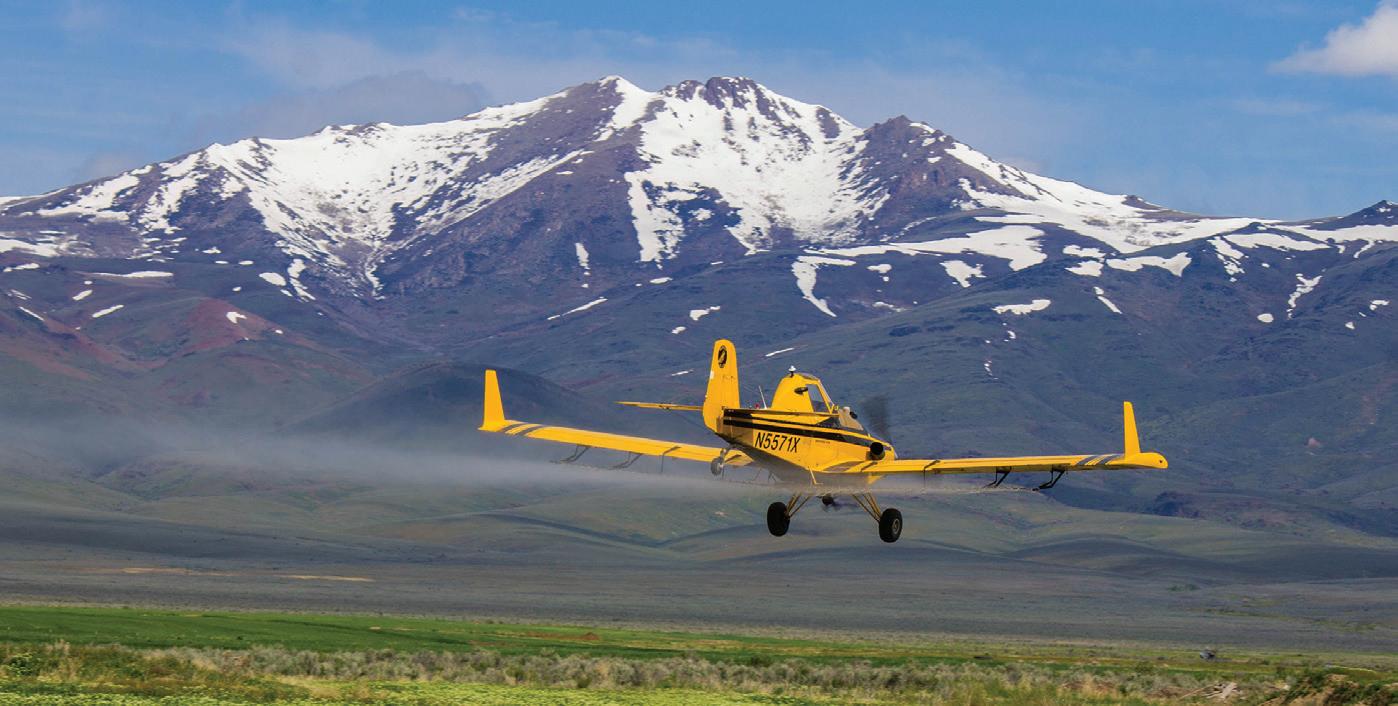
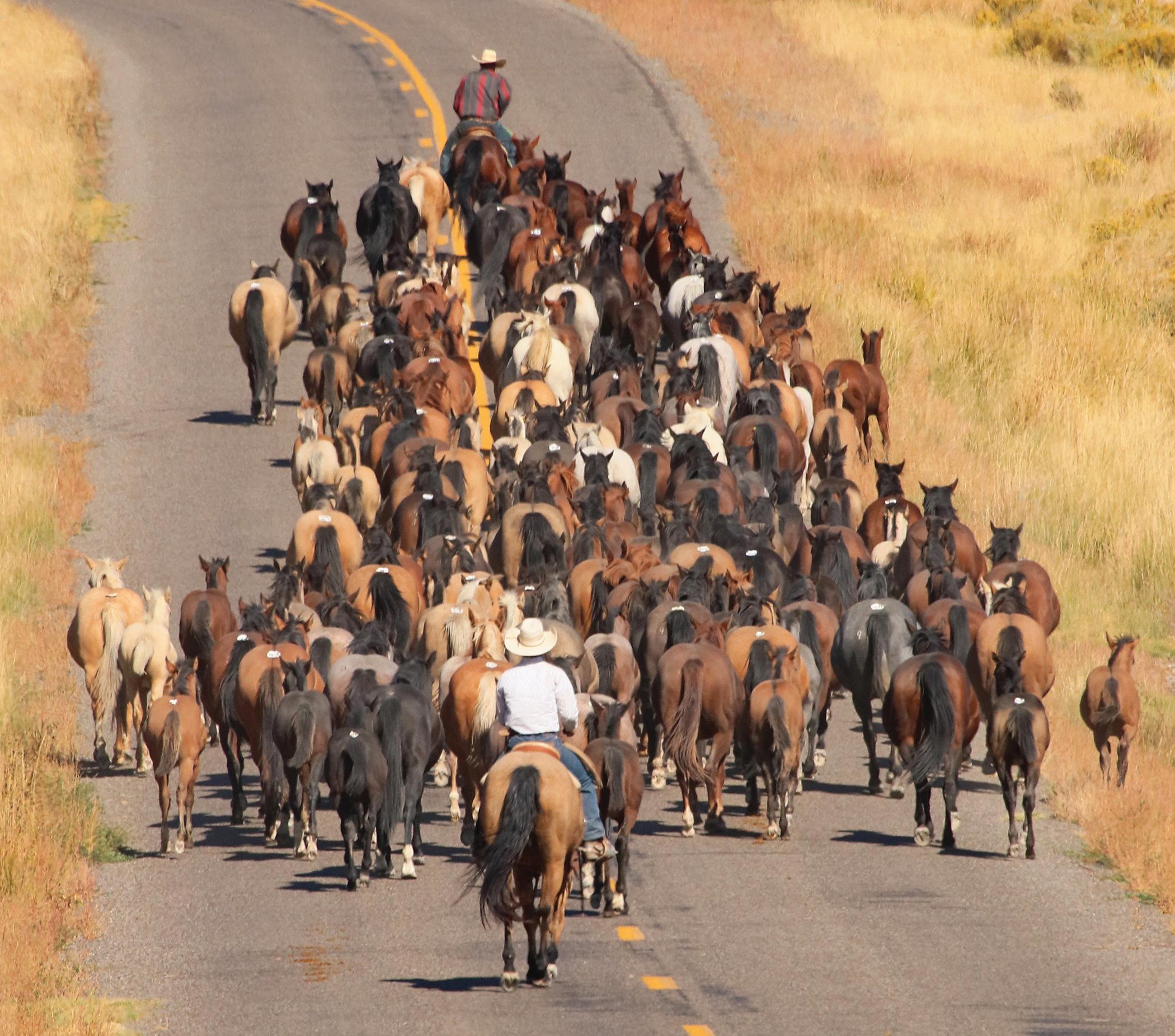
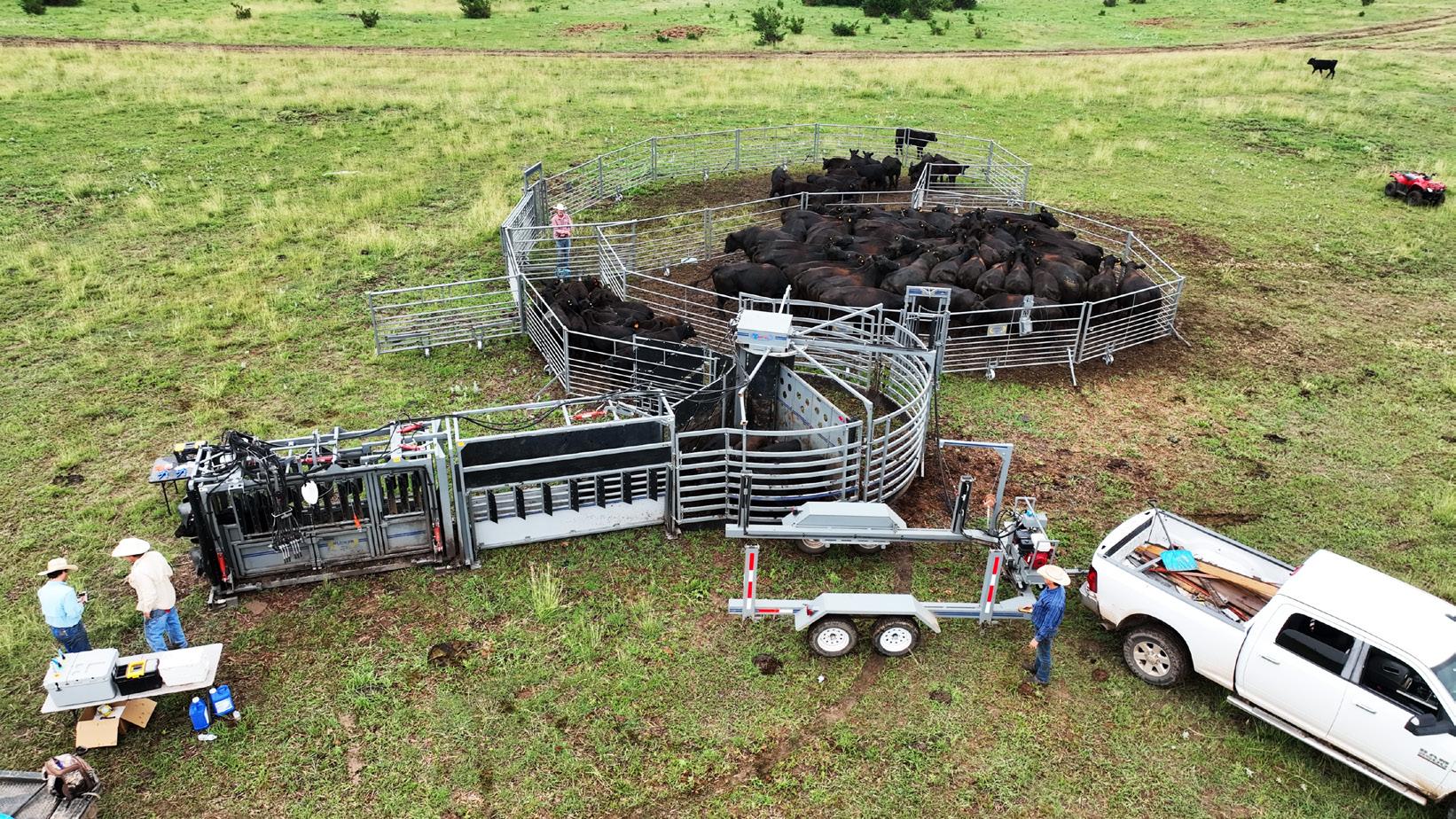





A note from Jack,
I am very concerned about the recent changes to LRP and the unintended side effects that may result from these new changes.

Mostly concerned that we gave up incentives for buyers to support real-time auctions at salebarns across America. 85% or more of the cattle in America cannot sell on video markets because they are too small of producers and don’t have the required numbers for truckload lots. I’m concerned buyers will always be full by staying out in front 4 to 6 months ahead of time now that they can insure cattle upon date of risk and not date of delivery. I’m not sure when God spoke from heaven and said all big producers shall sell 4 months ahead of all small producers. This is a battle we fight continually in the west, we rely heavily on California grass cattle buyers and they often say they have filled their needs on the summer video sales. This gives small producers a great disadvantage in the market place. I’ve raised these concerns to USCA, Common Ground Summit, and LMA only to be ignored because the largest players in the industry are in control of these groups. I don’t think it’s smart to support 10% of the industry while ignoring 90%.
My other concern is how CME will be effected by these large insurance companies/USDA when they short the
board for their own protection in this extremely volatile market. On the summer video markets like Western and Superior as well as Live.Ag and Northern you can see up to 500,000 head of cattle selling within a week. Before the new LRP changes these buyers could request an insurance policy upon delivery of the cattle, which after a large video sale would be spread over at least a 4 month period. Now with changes these same buyers can buy insurance the following Monday morning. I don’t understand how this concentrated volume of trades cannot trigger algorithms and drive the futures market down down down. Very concerning to have a multitude of taxpayer subsidized insurance companies having a negative effect on the American cattle industry. I have a kindergarten understanding of the futures market so you’ll have to dumb this down for me to understand. I may not fully understand the CME but I sure understand watching salebarn buyers lower their bids or pull off the market altogether on those limit down days.


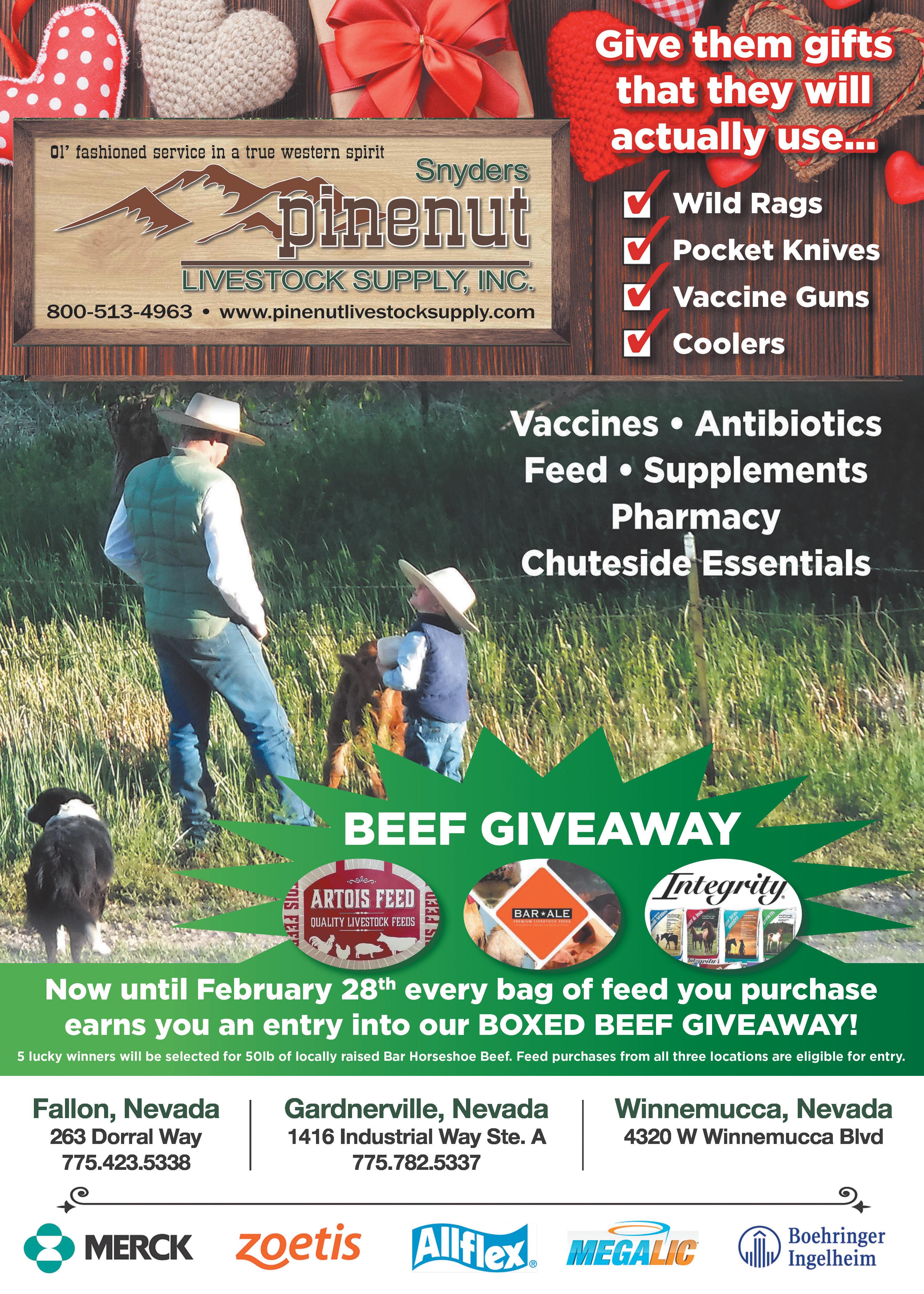
Subscribe today for Just $16 per year! (775) 623-5011
Read back issues digitally: issuu.com/winnemucca publishing7
The Nevada Rancher (ISSN 0047-9489) (USPS #003-257)
Published monthly at Winnemucca Publishing, 1022 S. Grass Valley Road, Winnemucca, NV 89445
Call us toll free at (866) 644-5011
Periodical Postage Paid at Winnemucca, 89445
President: Peter Bernhard
Publisher & Editor:
Ashley Buckingham
Staff Writer: Jennifer Whiteley
Contributors
Martin Paris, Randi Johnson, and Heather Thomas
Sales Representative:
Ashley Buckingham
Office Manager: Tracy Wadley
Graphic Design:
Ashley Buckingham
Joe Plummer
Emily Swindle
Jen Anderson
The Nevada Rancher does not assume responsibility for statements by advertisers nor products advertised within, and The Nevada Rancher does not assume responsibility for opinions expressed in articles submitted for publication. The publisher reserves the right to accept or reject advertising or editorial material submitted for publication. Contents in The Nevada Rancher may not be reproduced, in whole or in part, including, but not limited to original contents and original composition of all ads (layout and artwork) without prior written permission. Subscription rate: $16.00 per year. All content copyrighted, May 2025.
POSTMASTER: Send address changes to:
The Nevada Rancher, Winnemucca Publishing, 1022 S. Grass Valley Road, Winnemucca, NV 89445


It has been hot in Northern Nevada with a high chance of thunder and lightening storms starting many fires. It seems another dry year, but "it could be worse"
August brings county fairs, back to school preparation (break never seems long enough), and my birthday month!
The NV Rancher has been busy this month with cattle and horse sales.
As we creep into Fall work season and a few bull sales in the west, I hope you continue to enjoy the current season we are in. Often times planning and prepping for what is to come, consumes
our enjoy of what is happening ing now. Don't forget to sit and enjoy the moment.
Enjoy your county fairs, funnel cake and hopefully no more fires.
-I hope you enjoy this issue, Ashley
Below pictures is Ashley with friends and fellow CattleWomen, April Wilkinson and Shelby Taylor, purchasing prizes for the Tri-County Fair presentation day to help youth feel more confident at Fair.
Good Luck Showmen!
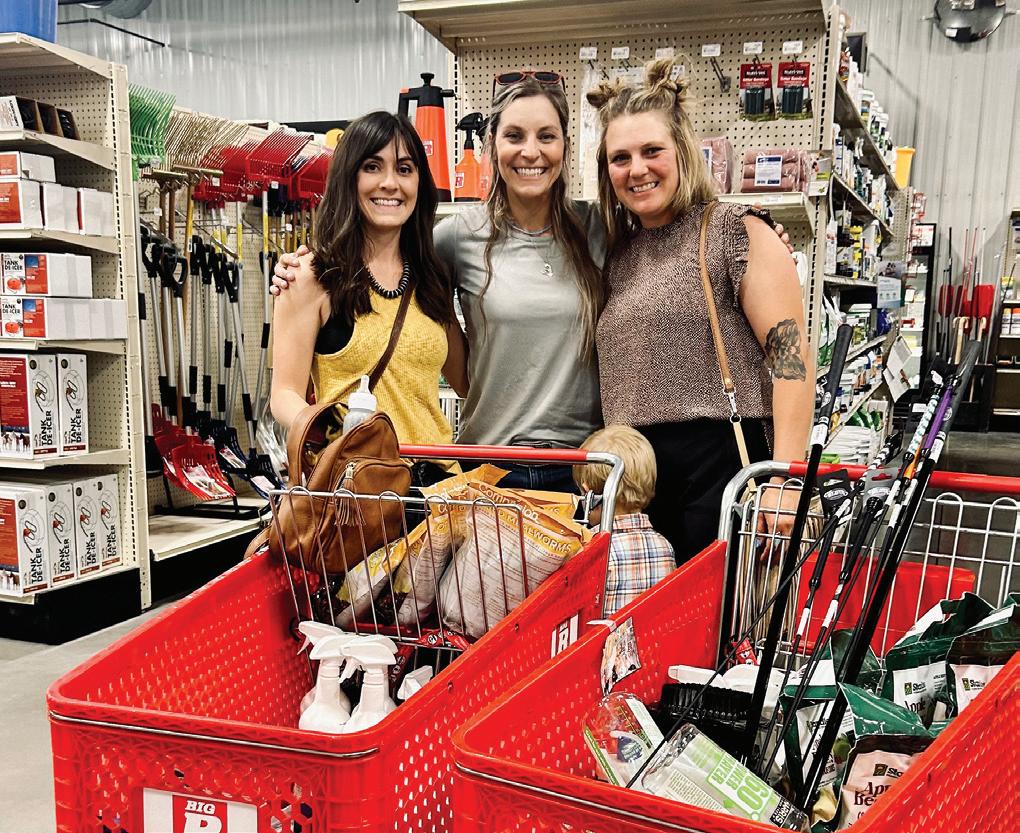
• Pg 6- Memory Ranch Highlight
• Pg 10- Managing Russian Olive Trees
• Pg 14-17 Purina Manure Comaprison
• pg 18- Partyline Cookbook Recipes


Robert "Bob" Cecil Bruce 3/17/19417/7/2025
Robert “Bob” Cecil Bruce, 84, of Jordan Valley, Oregon, passed away peacefully at home on July 7, 2025, leaving behind a legacy of family, love, and ranching. Bob was born on March 17, 1941, in Weiser, Idaho, to Cecil and Cathleen Bruce. He was the fourth of six children.
He attended elementary school in Manns Creek, Idaho and high school in Midvale, Idaho. At the age of 14, Bob began shoeing horses for $5 a horse and working with Ralph Stevens Rodeo Stock, where he discovered a love for saddle bronc and bull riding. By age 18, he had started his first career as a rodeo cowboy, competing in rodeos throughout Idaho and Oregon. Over the next eight years, he became a well-regarded and accomplished saddle bronc rider.
In 1959, Bob began working in construction for McGregor Triangle Construction. A quick learner, he became an expert heavy equipment operator, with a
Patsy Lee (Dougherty) Aitken
12/29/1925 - 07/01/2025
Patsy was born on December 29, 1925 to Verne Wellington (Mike) and Ivy Ione (Toni) Mckimmy Dougherty in Oakland, California. She joined her sister Frances Ellen (Betty). A few years later, sister Danna Verne was born making the family complete.
Soon after graduating from Roseville High School, she married the love of her life, John Hill Aitken on June 29th, 1944. Into their family they welcome five children: John Jr., William, Thomas, Susan, and Bethany. They resided in north ern California until purchasing ranches in Humboldt County in 1964.
particular talent for running dozers. His construction career spanned the Columbia River in Washington and Oregon, Hells Canyon in Idaho, and numerous other projects across the Northwest.
In 1966, while working on Highway 95 in Jordan Valley, Bob met the love of his life, Carol Staples, at the Jordan Valley Café.
They were married on October 8, 1966, in Jordan Valley, and Bob continued his work in construction. In 1971, Bob and Carol moved to Jordan Valley and began ranching with Carol’s family in Pleasant Valley/ South Mountain, Idaho—at what is now known as Bruce Ranch.
Bob was a devoted husband to Carol and a proud father to their five children: Andrea, Richard, Ryan, Jenny, and Josh. He was also a loving grandfather to eight grandchildren, all of whom brought him great joy. Family was always Bob’s highest priority—he would do anything within his power to support his wife, children, and grandchildren.
He had an incredible work ethic and a deep passion for ranching. For over 50 years, Bob dedicated himself to raising cattle and improving the land at Bruce Ranch. He didn’t have traditional hobbies—his joy came from working outdoors and being involved in his children’s and grandchildren’s lives. He also loved a night out with music and dancing, and his favorite song was “We’re from the Country and We Like It That Way.”
In 2005, with his two sons taking on more of the ranch responsibilities, Bob returned to one of his favorite lines of work: construction. He spent nine years working on the Delamar Silver Mine reclamation project, where he brought his expert equipment skills and thoroughly

Patsy went to work at Humboldt County General Hospital where she was an aide in labor and delivery, caring for mothers and newborn babies for many years. Before retiring, she was head of housekeeping for several years. She was a member of the Church of Jesus Christ of Latter-day Saints and held many teaching positions.
Surviving Patsy are her children: John (Ilah), William (Libby), Thomas (Connie), Susan (Russell) Kenison, and Bethany (Jim) Thompson. Her living posterity includes 20 grandchildren, 69 great-grandchildren and 3 great-great grandchildren and many nieces and nephews. She was preceded in death by her husband, parents, sister Betty, grandchildren Michael and Julie and great-granddaughter Sierra.
The family would like to express their appreciation to the nurses at HGH and to Doctors Musick and Perry.
Miriam Ida Woodward Toland June 3, 1936 - May 22, 2025
Miriam was a wonderful, strong, loving thoughtful person, exceptional Mother and will be dearly missed by many. Miriam Ida Woodward Toland passed away May 22, 2025, just days shy of her 89th birthday.
She was born June 3,1936 in Winnemucca, Nevada to Adelle and Harold Woodward of the Woodward Ranch, Dyke, Nevada. Miriam was raised on the ranch with her three sisters, Haroldine, Jo and Delia.
She attended the small schoolhouse located right on the ranch and graduated with Humboldt County High School class of 1954.
She worked at the Sonoma Inn (present day Winners Inn) while she was in high school, savings funds to attend floral school in Denver, Colorado.
Miriam and high school friend Janice both attended the floral school together, starting their own flower shop in Winnemucca. Miriam continued to create flower pieces for friends for many years after selling the shop.
She married Don L. Toland on April 1, 1955. They lived several places in Nevada, settling in Winnemucca. They started a family business while raising their children. She loved being out in the Nevada hills hunting arrowheads and purple bottles, and great at finding wild mushrooms which she cooked to perfection!
Her cooking skills were amazing. There was nothing she wouldn’t try and became adept at old family recipes as well as anything new she tried.
She shared her passion to cook with anyone who showed interest. A few of her handmade specialties included ravioli, yeast rolls, and her delicious cheesecake.
She was known for her Panetone, an Italian fruit bread that was baked in tin coffee cans, the smell fresh out of the oven was amazing! Sugared walnuts flawlessly handled in a cast iron fry pan were a special treat, along with the anticipated and requested deep fried Crusties.
She had her recipe box and favorite cookbooks with her at Harmony Manor, just in case, freely sharing her recipes and excellent cooking advice.
Miriam always had a big vegetable garden with beautiful mari
enjoyed both the work and his co-workers.
Bob never met a horse he didn’t like—or a person he couldn’t strike up a conversation with.
In fact, as his son Ryan recalled, during the Christmas seasons of 1980’s, you could always find Bob at the Karcher Mall, sitting near the Thoroughbred restaurant, talking with a farmer or someone else from the valley while waiting for his family.
It seemed to be a gift from God—Bob’s natural ability to connect with people. He truly enjoyed hearing others’ stories, and more often than not, he’d discover a shared history or crossed path. And if not, that was fine too—he simply enjoyed learning about other people’s lives.
Bob is survived by his wife Carol Bruce, his daughter Andrea (Kevin), son Ryan, daughter Jenny (Cole), son Josh (Alicia), his siblings, Jerry (Lynne) Bruce and Bill Bruce and eight grandchildren.
He is preceded in death by his parents, Cecil and Cathleen Bruce; his brothers, Claude and Lawerence Bruce; his sister, Emma Lou Bruce; and his son, Richard Bruce.
Bob’s energy, work ethic, and unwavering devotion to his family will never be forgotten. His legacy lives on in the hearts of his loved ones—and in anyone who values hard work, connection, and building a life with purpose.
The family would like to extend a heartfelt thank you to Dr. Swerdloff and the Hematology/Oncology team of St. Luke’s Nampa Medical Center.
Memorial donations in Bob’s memory may be made to St. Bernard’s Catholic Church or Jordan Valley Lions Community Center.
golds scattered throughout, “They keep the pests away”. The garden kept the kitchen busy with canned vegetables, jams, jellies, fruit, tomato sauce, relish, pickles, sauerkraut, and juices to store in the cellar. She managed to give away an immense amount of zucchini every year! Miriam loved to fish and to hunt, bagging her last Muley buck at 78 years old. She was skilled at cutting and wrapping all meats, beef, venison, lamb, pigs, and poultry. Her ability as an old school butcher made practical and effective use of a handsaw and several sharp knives. When they updated to electric meat saws the men did the cutting while she continued with the slicing, boning and wrapping. She knew how to prepare and cure hams, sausage, chorizo, corned beef and jerky. This was always a family endeavor.
Miriam loved to knit heavy zip up collared sweaters with hand drawn motifs knitted in. Many friends and family were gifted one of these beautiful sweaters. Miriam enjoyed reading, her Thesaurus and dictionary were dog- eared and falling apart from daily use solving crossword puzzles. She loved to tell wonderful stories of growing up, sharing the history of Winnemucca and the Woodward Ranch. You could ask her any question of who was related to whom and she just always knew the answer.
Miriam is survived by her children: Keith (Coleen) Toland, Loreen (Nate) Blanton, Mark Toland, grandchildren: Jennifer Toland, Jeff (Amber) Toland, John (Kelse) Toland, Jessica Toland, Barbara Toland and family, Garth Toland and family, great grandchildren: Mackenzie (Fernando) Angeles, Sierra Fears, Hunter Fears, Makenna Toland, Charleigh Toland, Vynessa Y. Toland, Lee W Toland, Morgan Toland, sisters: Haroldine Searle and Delia (Rob) Nuffer, numerous nieces and nephews, longtime friend Jean McDonald
Preceded in death: parents, husband, son Lee Malcolm Toland, grandson Andrew John Blanton, sister Jo Woodward Bidart
We extend unending appreciation to the Harmony Manor nurses and CNA’s that cared for Miriam daily and loved her as much as we did.
A very special thank you to Julie and Hortencia for taking such loving care of her over the last few years.
No services are pending at this time. In lieu of flowers please consider a donation to the Joshua Rose Memorial Scholarship Fund.
For more information about the roping event and to view the sale catalog, visit www.memoryranches.com.
Please enjoy a fun highlight on a memorable livestock operation, Memory Ranches located in Clover Valley, NV, just North of Elko, NV.
When Merry and I were married 53 years ago, we were just a couple of young kids with big dreams and no money. We dreamed of owning our own cattle and horse ranch someday. However, in college, we were told that with the economy the way it was, unless you inherited a ranch, you could never own one. But we discovered that the American Dream is still alive and well. Instead of buying furniture and all the things our parents had, we bought one cow at a time and built our registered herd.
Today, we market 150 black and red Angus yearling bulls through a private treaty each year. We’ve been artificially inseminating our cow herd for over 50 years, focusing on traits like calving ease, growth, carcass quality, good udders, and efficiency. We avoid single-trait selection, preferring to maintain balance. Moving to Nevada allowed us to start Pulmonary Artery Pressure (PAP) testing our bulls, and research shows that PAP-tested sires help reduce respiratory problems in their offspring.
We also run 100 head of broodmares and host an annual production sale every August. We’ve been raising ranch and performance horses for over 20 years now. The rugged East Humboldt Mountains sit in our backyard, providing an ideal environment for developing horses physically. They learn to navigate rocky terrain and steep country, which builds their strength and agility. Horses are mobile creatures and were never meant to be confined to stalls. We’ve found that letting them grow and mature outdoors enhances their ability to perform in the arena.
What Sets Your Production Bloodlines Apart from Other Horse Operations?
Historically, rope horses have often come from the rejects of other disciplines. However, our foals are the result of many generations of proven bloodlines, carefully selected for ranch and rope performance. Before having a foal sale, we held a gelding sale for many years, selling 70 head of 3-5-year-old geldings that we bred, raised, and trained entirely on the ranch. For 20 years, we rode every colt born on the ranch, becoming intimately familiar with the disposition, trainability, and athletic abilities of our stallions and mares. We stopped breeding horses that didn’t consistently produce the traits we were selecting for. We don’t just breed for looks—we’ve ridden these horses and proven them both on the ranch and in the arena.
When’s Your Next Sale, and How Many Are You Selling?
Our next sale is Saturday, August 23rd, at our ranch in Wells, Nevada. We’ll be auctioning off 83 horse colts and fillies. They’ll run through the ring beside their mamas, though they won’t be quite ready to wean that day. We’ll wean them, break them to lead, and have them ready for pickup by their new owners starting in October. On sale day, we’ll also host a breakaway and team roping jackpot. For more information about the roping event and to view the sale catalog, visit our website at memoryranches.com.
What Are a Few of Your Favorite Lots?
That’s a tough question because the answer would be different depending on who you ask at the ranch. Picking a horse for someone is a bit like picking a spouse; everyone is looking for


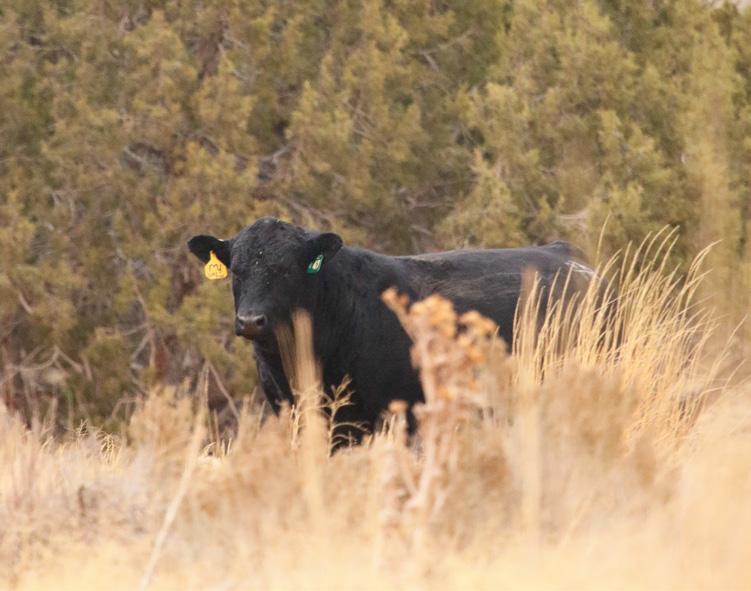
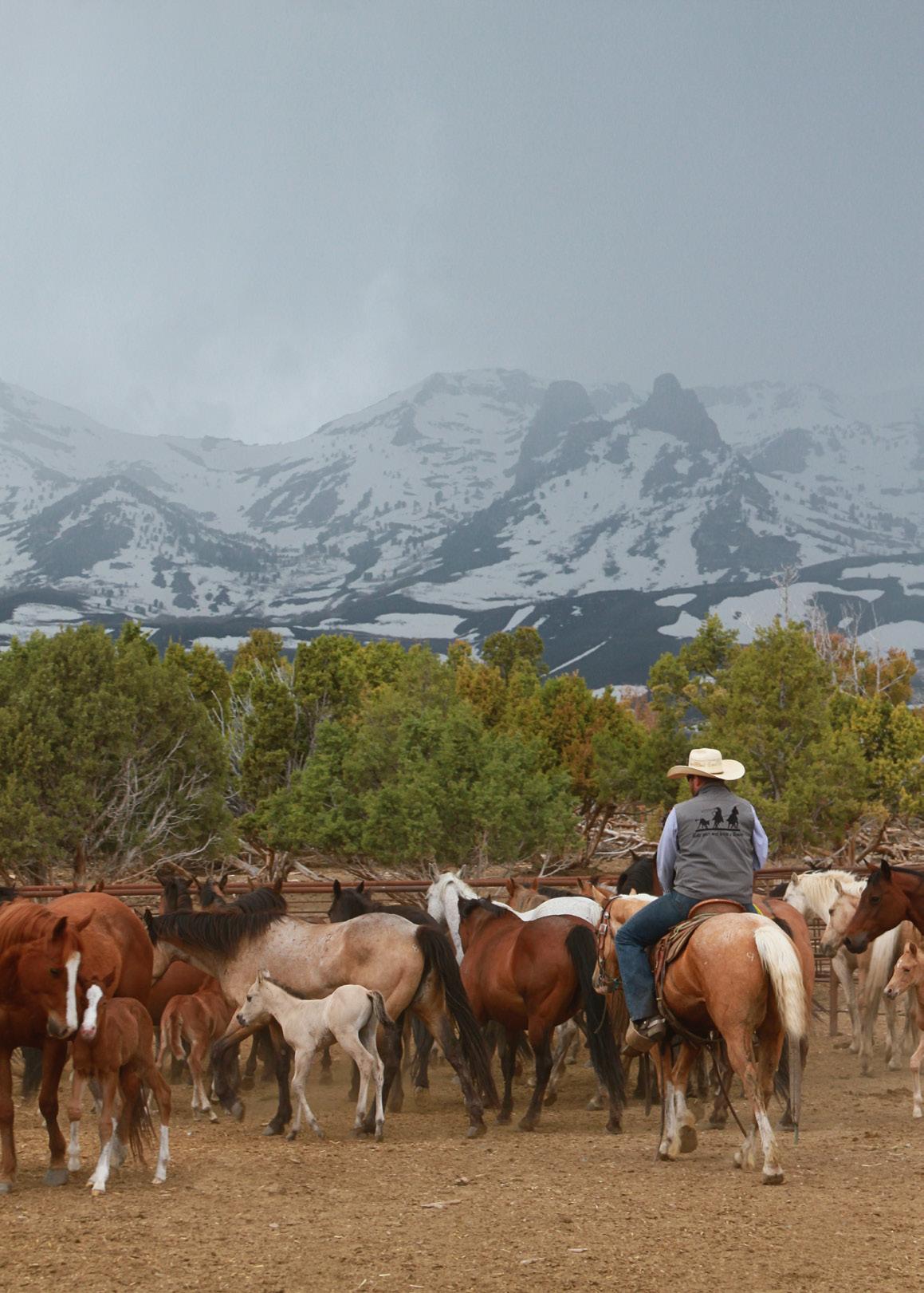



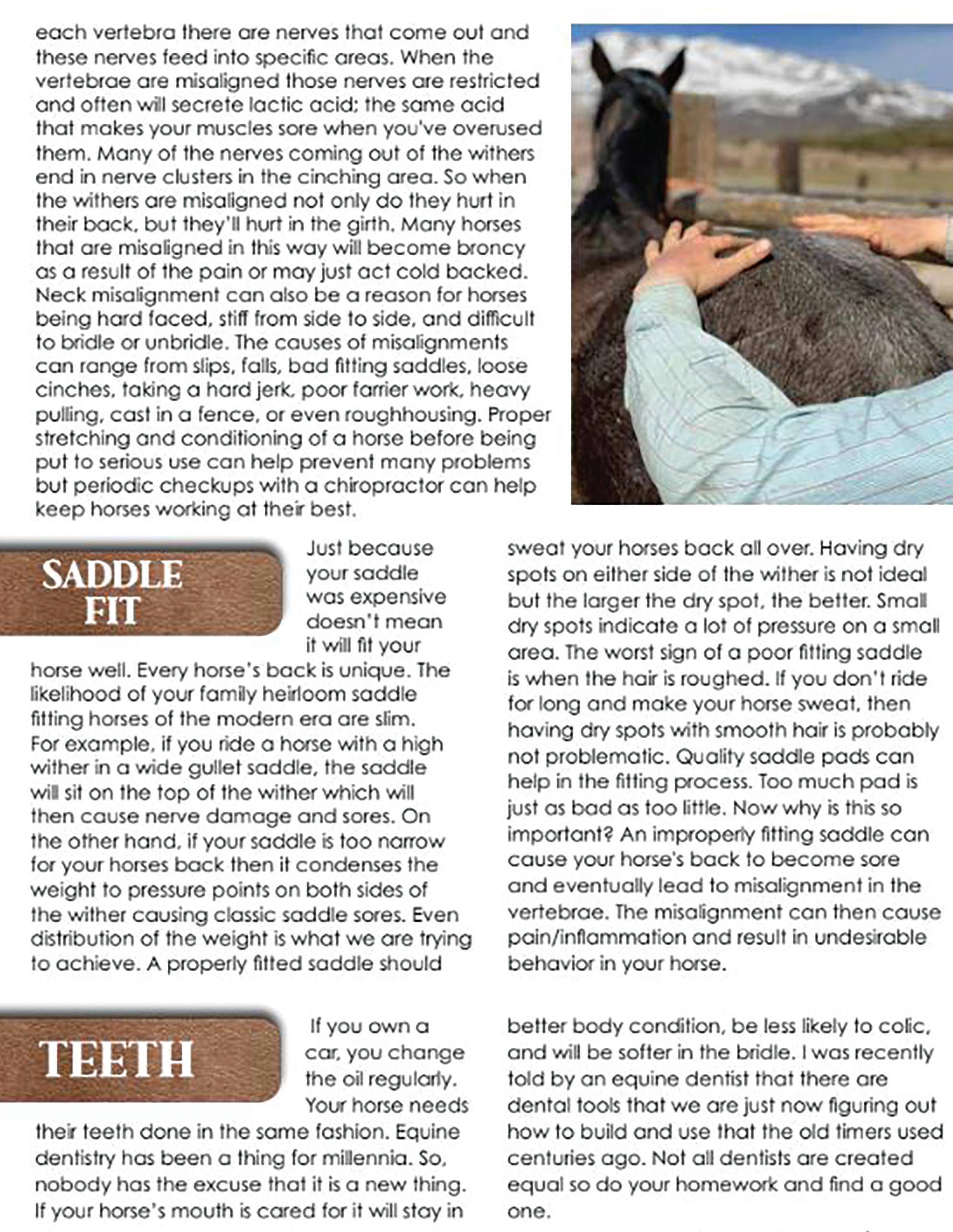
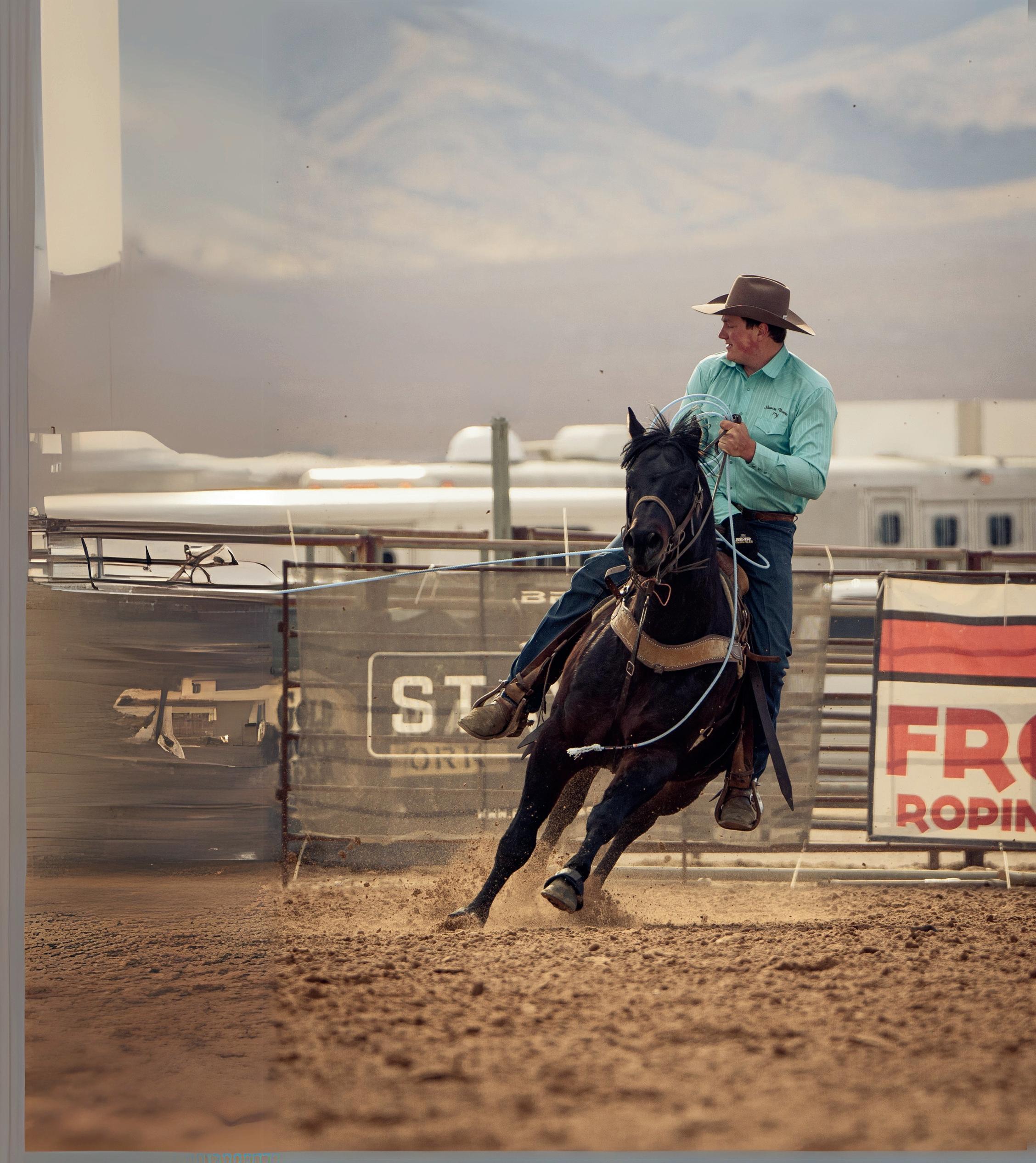


BY MARTIN PARIS, NCA
DIRECTOR
Celebrate with us the 90th Annual Nevada Cattlemen’s Association Convention and Tradeshow. Our convention will be in Elko this year on November 13 –15.
Please be sure to check out our website at www.nevadacattlemen.org for more information as things begin to take shape. We’re looking forward to another productive convention this year with some great speakers and good topics.
I’m starting to see stores stocked with back-to-school items, so that must mean August has arrived. This month I wanted to take a moment to talk about the whirlwind of things happening within the livestock industry that NCA has or continues to be engaged in- starting with the passage of the One Big Beautiful Bill (OBBB). The bill, which was signed into law on July 4, had some pretty significant victories for livestock producers across the country when it comes to tax benefits for livestock producers.
• Stepped-up Basis: The OBBB maintained stepped-up basis. This is an adjustment of the value of inherited assets to the current fair market value for taxation. Stepped-up basis minimizes capital gains taxes owed if the asset is later sold.
• Section 199A (Qualified Business Income Deduction): Was set to phase out at the end of the year but was made permanent. This allows owners of passthrough entities like LLCs, S corporations, and partnerships to deduct up to 20% of their qualified business income.
• Section 179 Expensing: Was increased from $1 million to $2.5 million, allowing businesses to deduct more upfront for things like equipment.
• Bonus Depreciation: 100% bonus depreciation was made permanent which allows business to immediately depreciate 100% of qualified assets/equipment in the year they are put into service, rather than deducting depreciation over several years.
• Death/Estate Tax: Maybe one of the most important, the exemption level of the Death Tax was increased to $15 million per individual and $30 million per couple. Over the years the Death Tax has forced many family ranches to sell off land, equipment, or cattle to pay the tax.
The One Big Beautiful Bill also increased the Livestock Forage Disaster Program to two monthly payments instead of one and allows the program to kick in after 4 weeks of consecutive drought, instead of the previous 8 consecutive weeks. The Livestock Indemnity Program will now fund indemnity payments at 100% of the market value of livestock losses due to predation and 75% of market
By Hanes Holman, NCA President
It is the fourth of July as I sit down to write this article. All over America, the American people are cleaning their barbecues and seasoning some amazing beef products, getting ready to celebrate our independence. Beef sales skyrocket on the 4th, as my favorite season is in full swing - Grilling Season!
As I reflect on the meaning of the Independence of America, I am reminded of the saying that “an army runs on its belly”. Anyone who was at the NCBA convention this year would have hopefully had the pleasure of hearing NCBA’s CEO, Colin Woodall’s speech on beef at the Alamo. Colin, who is the very best public speaker I’ve ever witnessed, spoke about Colonel Travis’s spirits being uplifted
when they managed to get beeves into the Alamo to have beef for dinner.
I truly believe that a nation’s power lies in its ability to produce agriculture.
A country that can’t feed itself won't be a free nation for very long. I don’t feel it is a reach at all to say that when we celebrate the freedom of the 4th, the beef industry and the American rancher should be the first thing to come to mind to thank. Our industry played a major role in liberating America and continues that role in keeping us free!
Hopefully everyone in American had a chance to go enjoy a rodeo, shoot off some fireworks and have a tasty beef product this 4th of July.
Cheers,
Hanes Holman
On the Bureau of Land Management (BLM) front, BLM also appears to be placing an emphasis on multiple- use management and innovation over regulation. There is an active effort to streamline regulations that hinder things like grazing management. This includes revising the controversial Conservation and Landscape Health Rule or “Public Land Rule”, improving the efficiency of NEPA processes to expedite project approvals, updating Resource Management Plans to better align them with current needs. BLM will also be placing an emphasis on aligning sage grouse management plans with state-level strategies, which has been a key goal of NCA’s efforts. BLM expects to have new sage grouse plans developed later this fall.
value for losses due to adverse weather. All of these provisions will provide some much-needed relief to livestock producers within Nevada.
It's also worth highlighting some of the big changes coming to federal land management that NCA has long advocated for. Starting with the United States Forest Service (USFS). The USFS is undergoing significant changes aimed at improving land management and addressing various regulatory challenges. There appears to be a renewed emphasis on active management of forest lands, including plans to increase timber harvesting to levels not seen since the early 1990s. This includes deregulation efforts to streamline processes and enhance efficiency. Forest Service is rescinding outdated regulations, such as the 2001 Roadless Rule, which previously restricted management practices including firefighting capabilities on certain lands.
The agency is prioritizing graz ing management, recognizing its importance to the ecosystem and rural economies. This includes addressing vacant grazing allotments and enhancing collaboration with ranchers. Changes to the National Environmental Policy Act (NEPA) are being implemented to streamline environmental assessments and reduce bureaucratic delays, allowing for quicker project approvals. The Forest Service is focusing on wildfire prevention and management, integrating grazing practices into fire mitigation strategies to reduce hazardous fuels.
On the Bureau of Land Management (BLM) front, BLM also appears to be placing an emphasis on multiple- use management and innovation over regulation. There is an active effort to streamline regulations that hinder things like grazing management. This includes revising the controversial Conservation and Landscape Health Rule or “Public Land Rule”, improving the efficiency of NEPA processes to expedite project approvals, updating Resource Management Plans to better align them with current needs. BLM will also be placing an emphasis on aligning sage grouse management plans with state-level strategies, which has been a key goal of NCA’s efforts. BLM expects to have new sage grouse plans developed later this fall.
As we continue to progress through the year, NCA is also engaged in various other efforts including legislative changes to the Endangered Species Act, responding to ongoing petitions to list species on the Endangered Species Act including the Tui Chub and Monarch Butterfly, revising BLM grazing regulations, and much more.
On a final note, please save the date for our upcoming 90th Annual Nevada Cattlemen’s Association Convention and Tradeshow. Our convention will be in Elko this year on November 13 –15. Please be sure to check out our website at www. nevadacattlemen.org for more information as things begin to take shape. We’re looking forward to another productive convention this year with some great speakers and good topics.
That’s all for this month. Don’t hesitate to reach out to our office 775-738-9214 with any questions or input or reach out to us at nca@nevadabeef.org.

Auction will be online Friday, August 22 through Saturday, August 30, 2025.
cowboyartsandgearmuseum.org
The Cowboy Arts & Gear Museum (CAGM) proudly presents the 2025 Made for the Ride Challenge, celebrating craftsmanship in the western trades. This year’s challenge features three distinct categories:
Spur Straps (5 Makers)
Bosals (6 Makers)
Belt Buckles (4 Makers)
Dawn Cline the maker behind 5c Metalworks, L.L.C. in Lebanon, Missouri. I grew up in south central Missouri on a very small farm and I’ve always been the weird art kid. My parents thought I would go into art as a career but, not being one to conform to anything, I actually went to school to be a paramedic and I’ve been in emergency medicine for 25 years. Growing up I had an unhealthy fascination with all things western and horse related and especially loved the patterns in leather and silver work.
Fast forward, and life happened. I grew up, had a career, husband, children and focused less on my art. Mostly using it as an outlet when I needed a break from whatever stress I had. A divorce, sale of a house, and the death of my dad when I was 41 prompted me to do something for myself for a change. After being the caregiver most of my life I took care of myself. \ Using some the money from selling my house, I jumped in and bought equipment, supplies, and took classes with the goal of learning
This event honors the artistry and skill of makers while supporting the mission of CAGM to preserve and promote the heritage of the cowboy trades. Proceeds will benefit both the makers and the CAGM, a 501(c)(3) non-profit organization dedicated to keeping the spirit and tradition of the American West alive.
The Cowboy Arts and Gear Museum is nestled in downtown Elko, the Museum opened in 2017–2018 in the original G.S. Garcia Saddle & Harness Shop, built and operated by legendary artisan Guadalupe Santiago Garcia from 1907 to 1933
Garcia’s renowned “Garcia Beauty” saddle earned gold medals at the 1904 St. Louis and 1905 Portland World’s Fairs and cemented his reputation across the West After decades as a utility office, NV Energy restored and donated the building to become the museum, preserving its cowboy heritage.
Today, the museum showcases vintage saddles, spurs, bits and gear, hosts gear competitions, classes, and exhibits honoring Western craftsmanship
silversmithing and engraving. That was four years ago and I have never looked back. Engraving and silversmithing has become a passion I can’t seem to get enough of. I love the challenges and the constant evolution it brings with it as well as being able to keep this western tradition alive.
Most people wouldn’t associate western art with a small town girl from Missouri, but I’ve never been a conformist. I’ve always happily marched to beat of my own drum and continue to do so. Every day I look forward to drawing designs and watching them come to life and, when I can, I incorporate just a little bit of Missouri girl into my work.
The buckle I am creating I have affectionately titled “Home”. The Dogwood flowers and honey bee are the state flower and insect of Missouri. This is my way of infusing my southern home with my love and appreciation for the West and it brings me joy to know that someone will appreciate and cherish my work enough to wear it as a symbol of the things I love.





By Heather Smith Thomas
In Nevada, the tree that probably causes the most controversy is the Russian olive (Elaeagnus angustifolia), a tree that is both loved and hated. Some land managers and Nevada residents feel it is an important and valued component of arid landscapes, while others consider it an invasive weed tree.
The first known planting of Russian olive trees in Nevada was in 1906. Its ability to thrive in various environments soon led to its widespread use for windbreaks and ornamental plantings throughout the West. Many people liked these trees because of their long, full branches that can block heavy winds. Their small, silver leaves make them an attractive tree that can enhance a home-owner’s yard and garden.
Soon after its introduction, however, Russian olive shrubs and trees began to escape their original locations and spread prolifically. This non-native species readily invades seasonally wet riparian habitats, where it is highly competitive and displaces native vegetation such as willows and cottonwoods. The fruit of the Russian olive can be used for food, but wildlife (except birds) generally prefer native vegetation. The thorny branches can interfere with movement of humans, livestock, and wildlife. Growth along the banks of waterways can restrict water flow and increase soil erosion.
The hardy Russian olive thrives in the extremely different and various temperatures, soils, and moisture levels in Nevada so it has been widely utilized for landscaping and windbreaks. Once established, however, it can become difficult to control. This aspect led Colorado, New Mexico, and five Utah counties to declare it a noxious weed, meaning it is illegal for a property owner to allow the plant to grow within those states or counties.
Fruit-bearing Russian olive trees produce large amounts of pollen. This aspect played such a big role in creating severe allergy symptoms in humans that in 1991 Nevada’s Clark County officials banned the planting of any more flowering olive trees.
Russian olive trees have become a huge problem in the wetlands and agricultural waterways of southern Nevada, where their impact on local ecosystems and infrastructure is most severe. The fast-growing woody shrub/tree grows 10 to 30 feet tall, with a spread greater than its height. Larger ones have trunks 20 inches or more in diameter. These invasive trees grow prolifically in seasonally wet habitats, forming dense stands that crowd out native plants; a Russian olive can suck up 75 gallons of water per day.
Thriving on poor soil, it has high seedling survival rates, matures in a few years, and often invades riparian
habitats where an earlier canopy of cottonwood trees has died. Its quick-spreading root system can choke out native plants and can be detrimental to the natural hydrology of riparian areas and stream banks.
This plant is native to Europe and Asia but was called Russian olive because it was thought to come from the area of Southern Russia around the Black Sea. It actually originated in Western Asia and Iran. Unlike foreign invasive plants like knapweed or cheat grass that crept in uninvited, Russian-olive was intentionally brought to North America in the early 1900s as a landscaping tree. People thought it would be useful as a windbreak and soil stabilizer. Unfortunately, Russian olive escapes cultivation easily, especially along riparian areas, and is invasive throughout most of the western states.
The seeds are spread by birds that eat its fruit that readily ripens in the western North American climate, but seldom ripen in cooler, moister areas like England. Birds are the main animals that enjoy the fruit. They eat the olive and discard the pit. If a bird dumps an olive pit in your yard or pasture, it could produce trees. This is a common way people find olive trees on their property without planting them. Since the 1950s these trees have invaded many areas of the West, especially in riparian areas where they form impenetrable masses, creating inferior wildlife habitat and minimal forage for big game and livestock.
These trees are difficult to control because they re-sprout from the root crown if they are mowed or cut down. Removal becomes more difficult as the bush size increases. Small ones can be pulled up or mowed several times a season, but it’s almost impossible to pull up all the roots and cutting them simply produces even more sprouts unless you immediately paint the newly-cut stump with a brush killing chemical. There are always seeds in the ground, and they readily grow after you remove the trees/bushes because this gives the young saplings more sunlight.
The most effective and least expensive control tactic is to prevent establishment in the first place. Not using Russian-olive as a windbreak or ornamental tree keeps it from escaping into adjacent areas where it is not wanted. It is important to monitor pastures and check for young trees. Small infestations should be treated early, with a goal to remove all the trees.
Live seeds persist in the soil for many years. Disturbed plants can regrow from lateral roots and other plant parts. When new infestations of Russian olive emerge, immediate application of control measures might eradicate the stand before it can develop an extensive root system and persistent seed bank.

Permanent control requires many years of monitoring and treatment until the persistent seed bank has been exhausted and all buds on the root system have been completely killed.
Some Pros:
Drought Tolerant: Once established, Russian olive trees require little water, making them ideal for arid or drought-prone areas.
Soil Improvement: As nitrogen-fixers, they enrich the soil, which can help nearby plants grow better—especially in poor or depleted soils.
Windbreaks & Shelter: Their dense growth and tolerance to wind make them excellent for shelterbelts, erosion control, and stabilizing stream banks.
Wildlife Habitat: They provide food (via fruit) and shelter for birds and small animals, especially in open or degraded habitats.
Fast-Growing & Hardy: They grow quickly and can survive in a wide range of conditions, including poor soil, salt, and extreme temperatures.
While they offer real benefits in the right contexts, they should be planted with caution due to their invasive potential in many regions.
Debbie Reid-Oleson comes from a large pioneer family in Idaho. Her great-grandparents settled in the Blackfoot River Valley in the 1870’s and Debbie and her kids are part of the 5th and 6th generation.
“I learned to ride at an early age, since I’m the oldest of my siblings and helped my dad with the cattle,” she says. I’m still riding, in my 70’s!”

She married George Oleson, a third-generation rancher, and their Lazy V4 Ranch is only 10 miles away from the ranch where she grew up--along the Blackfoot River. “I am working on a big project to remove Russian olive on our land, and I’ve had a lot of help from the local Soil Conservation office. We have about 500 acres along the river. Part of it is farm ground, but the rest is natural wetlands, swamp and sand hills next to the river. Russian olive trees gradually took it over. We’ve been here 45 years, and when I first came it was a beautiful place to ride through the little meadows,” Debbie says.
“At first it seemed nice to have a few trees, but soon I was no longer able to ride along the trails. They were closed in by trees that took over the entire riparian area. They got so thick the cattle couldn’t get in there and no grass grew anymore because it was too shady.”
She went to the Soil Conservation District to ask what could be done about these invasive trees. “Later there was a weed control workshop and the
presenter talked about Russian olive trees. Ron Patterson, who is now the Extension Educator in Idaho Falls, was the presenter; he’d done research for the University of Utah on how to get rid of Russian olives before he moved here,” she says.
“He said you can’t kill these trees by spraying. He told us we could kill them by cutting them off close to the ground, and treating the cambium growth ring that’s right inside the bark. This is the stump cut method he was experimenting with, applying chemical with a vaccine syringe gun to measure how much chemical he was putting on per inch around that stump. I started treating the stumps, but applied it with a brush.
We use Roundup, full strength rather than diluted. I buy cheap 50-cent sponge paintbrushes to dip in the chemical, and rub it around the cambium ring. You don’t need any chemical in the middle of the stump,” she says.
“Within 10 minutes that cambium ring turns fluorescent yellow and that tree does not grow back again! You can treat any size tree—big trunks 18 inches or more in diameter, or something as small as your little finger. You just dab a little chemical on those little ones after you prune them off at ground level and they don’t come back.”
This is labor-intense, but it works and you don’t have to keep doing it every year. “If you try to get rid of them by using heavy equipment to tip them over or pull them out of the ground, they grow back with a vengeance—with even more taking their place. You kill one, and all their friends and neighbors come back to the wake!”
Cutting them off and treating with Roundup works any time of year but the best time is in late fall or early spring when the sap is either being pulled down into the roots for winter or rising in the spring. If you do it in the fall you get a good kill,” Debbie says.
“We’ve had three grants to help with this, funded by the State of Idaho Dept. of Environmental Quality, administered through the Central Bingham County Soil Conservation District. The most recent one started in July
of 2023 and went through the end of December 2024. We spent 500 hours working on those trees.”
The local Soil Conservation District owns a tree shear and loans it to landowners to remove trees. “The shear can cut down enough trees in 3 hours to take several hundred human-hours to clean up; those trees create a huge mess because of the branch pattern and thorns. We’ve been cutting those trees, trimming off all the branches and burning those branches as we go. We cut up the big trunks and stack them in firewood lengths in an old boxcar. We’ve been heating our house with this wood for many years. If you cut those trees in November through January and put them someplace to dry, by the next fall they are perfect for firewood. This hardwood burns hot and long, with very little ash. It’s best to cut the tree when it’s green. If you wait until the tree is dry it is harder to cut and harder on your saw.”
She and her family figured out, by trial and error, the best way to deal with these trees. “If you just pile and burn them without removing branches (to enable the trunks to be close together in the pile), the limbs keep the trunks too far apart and you can’t keep a fire going. It simply burns all the little branches off and then you have big black logs that you can’t get to burn again,” Debbie says.
These invasive trees aggressively spread. “Their roots go parallel with the ground wherever there is surface water. If the roots are disturbed by a rodent, or an animal injures the root, it creates sprouts that come up in multiple places,” she says.
They tend to have multiple trunks, like a big bush rather than a tree. “We have some big trees that are 3 to 4 feet around their multiple trunks, but their roots are spread out. About 30 feet away, in a circle, all these little trees are coming up—all connected by the roots. Instead of taking time to cut down the big mother tree, we cut down all the little trees around it that are connected, and the big tree dies. Then you don’t have to figure out what to do with all that biomass from those big trees if you cut them. I have burned millions of pounds of Russian olive

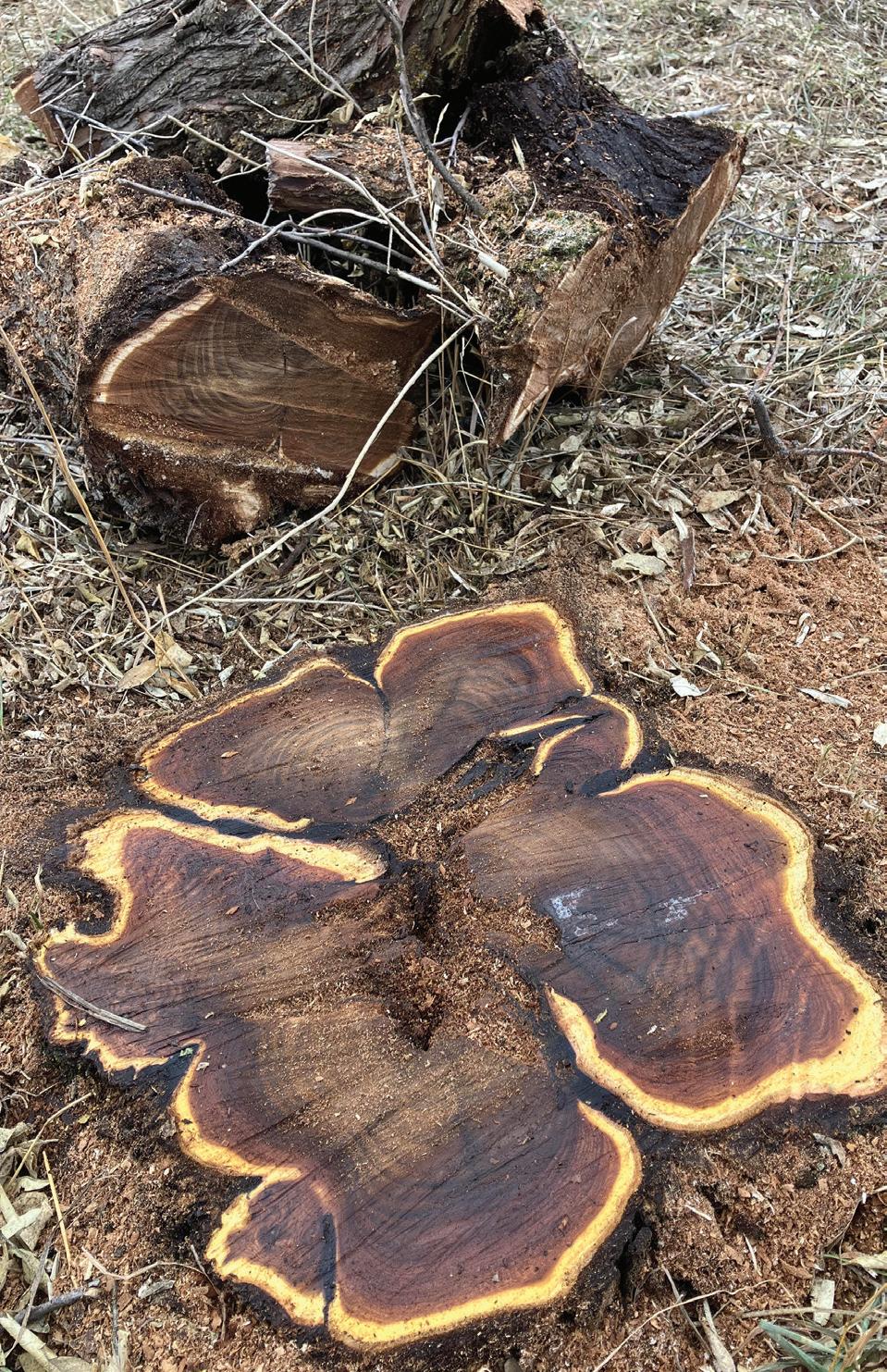
wood to try to get rid of them,” Debbie says. In earlier times people were encouraged to plant these trees; no one realized how invasive they would be. The University of Idaho was growing some, and promoting them, but like any foreign plant that isn’t native, these trees can outcompete other species and spread into areas they are not wanted.

We are experts in State of Nevada Water Rights. We provide a wide range of water right and resource development services that can be customized to meet your needs.
Our team works directly with you to develop the best solution for your farm, ranch, business or home.


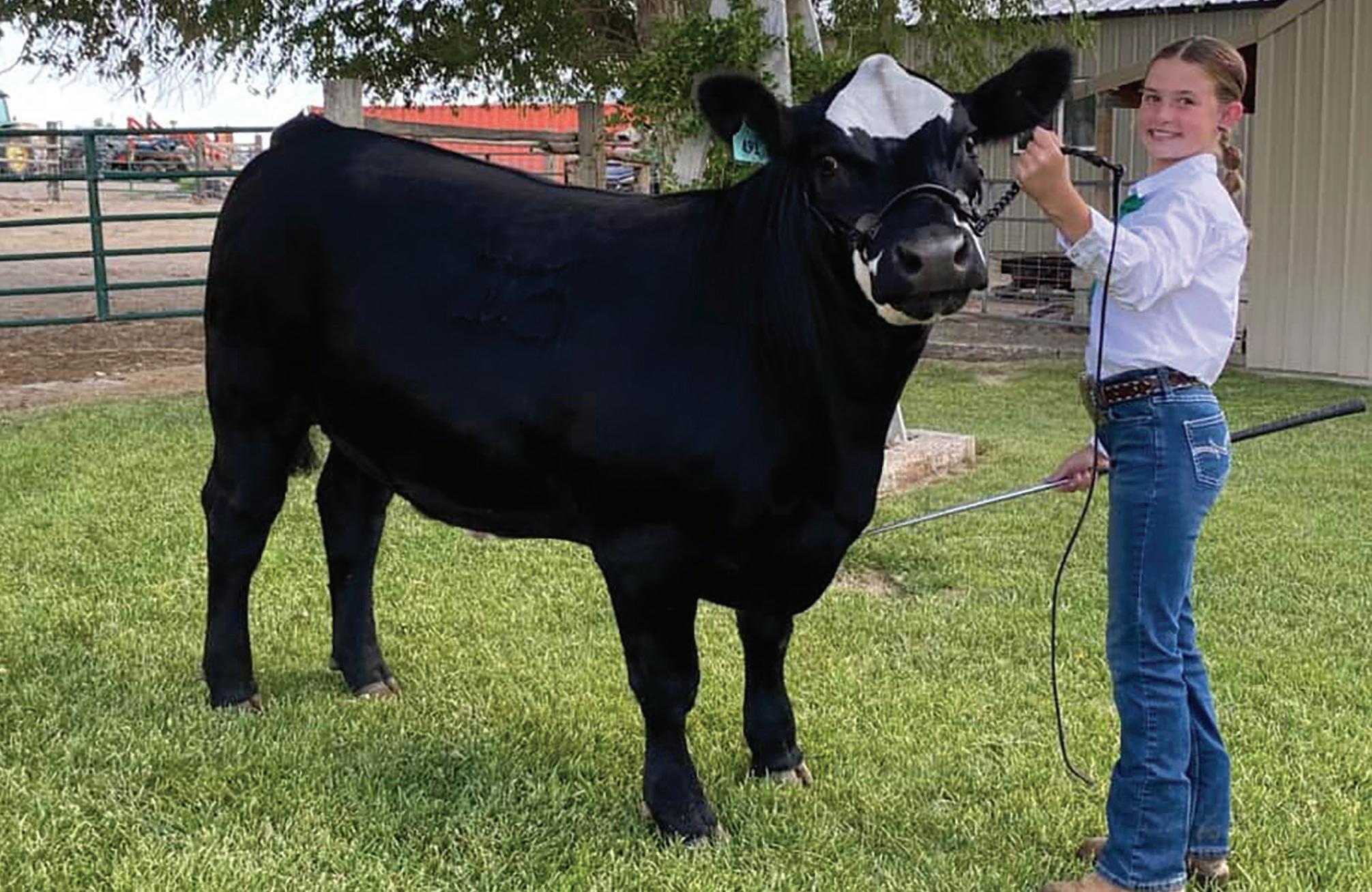

Every month the Nevada Rancher Magazine accepts photos to feature on the Ranching Scrapbook Pages. This edition the photo outreach post was: For the September edition we will accept photo submissions on Facebook or email to a.buckingham@winnemuccapublishing.net please limit 1 photo with name, caption and a few sentences about the photo. The prompt is “For the Love of Dogs”. Due 8/15

Submitted by Amber Clark. Her Children with 4H projects, it’s not just showing livestock!

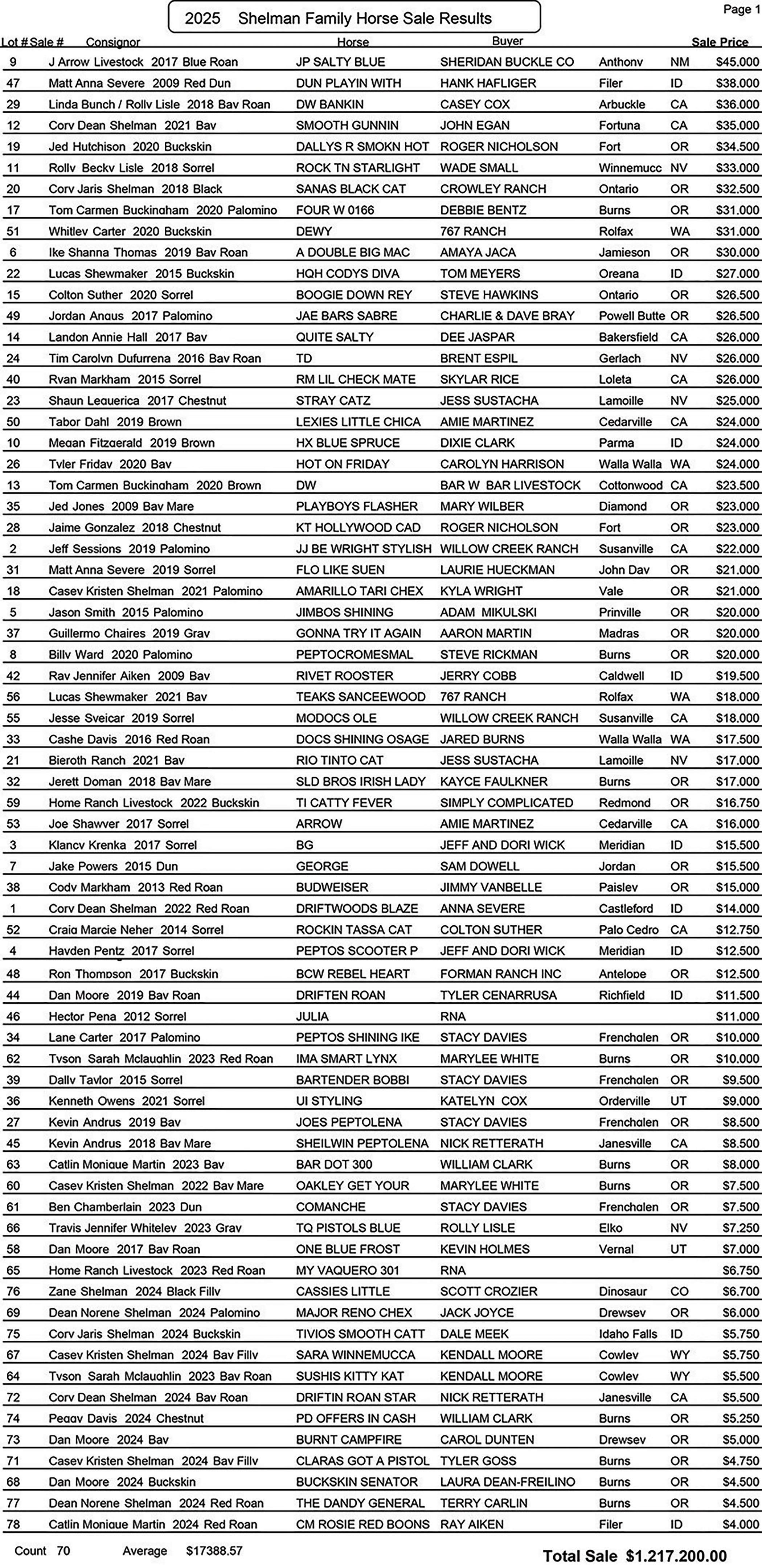
The Shelman Horse Sale in Oregon has a rich history, known for showcasing quality horses with strong pedigrees and performance records. Established in the mid-1900s, it quickly became a key event for breeders and horse enthusiasts.
Held annually, the sale offers a diverse selection of horses, from working ranch horses to high-performance competition animals. Over the years, the Shelman Horse Sale has built a reputation for bringing together top breeders, trainers, and buyers, fostering a sense of community in the equine industry. The event continues to highlight the best of Oregon’s equine talent, making it a must-attend for horse lovers.

Watch for next year's dates by visiting www. shelmanfamilyhorses. com and follow their page on Facebook.
Congratualtions to all of the consigners and buyers!


Evaluating cattle productivity often focuses on common benchmarks such as body condition, weight and feed consumption. Yet, there’s another informative — and sometimes ignored — performance indicator in plain sight: manure.

What comes out of the back end of your cattle can tell you a lot about your nutrition program. By utilizing a manure scoring tool, you can analyze your cattle’s manure and better understand how well the rumen is working to ensure your nutrition dollars are being used by the cow and not just passing through into their manure.
“Think of manure scores as a short-term report card on how the diet’s doing in the rumen,” says Ted Perry, cattle nutritionist with Purina Animal Nutrition. “By scoring manure on the 1-5 scale, you can gain insight into the rumen environment, optimize your nutrition program and get more out of your feed resources.”


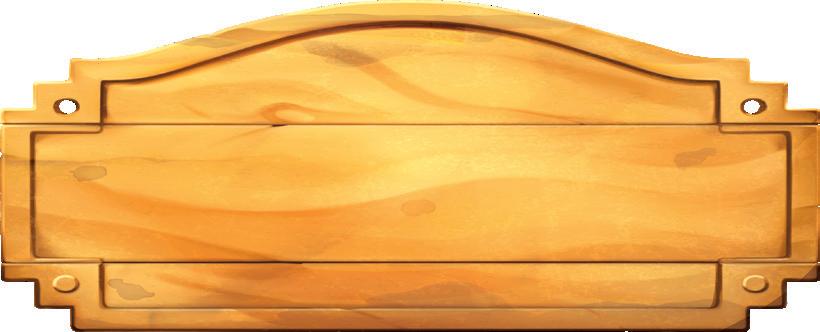









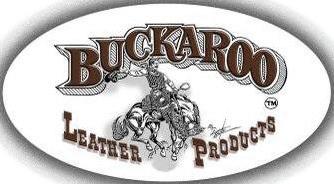

Manure score 1: The manure is more liquid than solid, with a cream soup consistency and possible gray color. The rumen isn’t functioning correctly, and what’s passing through is essentially water. This can also be an indication of acidosis and rumen upset. It is most commonly seen in feedlot diets.

lush in the spring.
Manure score 3: This is the ideal manure score to aim for yearround in your cow herd. It has a normal manure pat form and will be relatively firm and retain its shape.


Manure score 2: Manure doesn’t stack up properly. The manure pat is usually less than 1 inch thick and relatively runny or nearly liquid-like. The color will generally be the normal manure brown, typically experienced when forages are

score 4: The manure pat is thick and becomes more profound, yet it is not stacking. Rumen is not balanced for protein, carbohydrates and fiber degradability. It tends to
happen when corn is added to the diet, and you’ll see undigested corn particles in the manure.
Manure score 5: The manure pat is firm and stacks over 2 inches high. It can also resemble horse manure in its look because undegraded fiber passes through the rumen. You can break open the manure and see the fiber.

How can you improve manure scores?
Manure score 1 requires the most significant diet change and will need a lot of fiber, usually in the form of hay.
“You’ll also want to work with a nutritionist to adjust the diet properly when the manure score is so low,” says Perry. “If the manure score is 2, ensure a quality mineral balanced for trace minerals is available, along with providing any supplemental fiber.”
When scores are higher (4 and 5), supplementation can bring the rumen back in balance by increasing forage digestibility. Using a cooked supplement like a tub or block helps regulate the manure score by feeding the rumen microbes appropriate amounts of starch, protein, vitamins and minerals.


“If you feed the rumen microbes properly, you’ll get better forage digestion,” says Perry. “For instance, it’s not uncommon to see cows grazing corn stalks with protein tubs having a manure score of 3 because the rumen microbes have been fed right.”
To maintain an ideal manure score of 3, adjust your supplementation and mineral as forages change.
“Forage quality constantly shifts throughout the year, so your nutrition program must also shift,” says Perry. “Adjusting the nutrition program based on manure score helps keep the cow herd in optimum body condition score (BCS).”
When should you gather manure scores?
Manure scores can be gathered throughout the year. A good time to utilize this tool is in tandem with body condition scoring to get an even better idea of how your nutrition program is working. If you currently work with a nutritionist to help body condition score your herd, they can also assist you with manure scores.
“It’s also a good idea to check manure scores whenever there’s a diet change,” says Perry. “If you’ve moved the herd from one type of forage to a new one, like dormant native grass in late winter to wheat pasture, there will be a difference in the manure.”
Similarly, if you’re grazing pasture or feeding hay and consistently see a manure score of 5, it’s time to make a change with some supplementation and minerals. Three to four days after making a diet change is the ideal time to reevaluate manure scores because the rumen has had enough time to adjust.
“Much like body condition scoring, manure scoring can quickly tell you how your herd is performing and help you make important nutrition decisions,” says Perry. “Incorporating this tool into your regular management routine can give you valuable insights to ensure your nutrition program is as efficient and effective as possible.”

Cross L Ranch, Railroad Valley, Nevada
*3,314 deeded acres *Water Rights *Winter and Summer Range *339,266 acres of BLM to run cattle on *1500-1800 tons per year (to feed and sell)
*Cattle and Equipment Included *several home for the help and new home for ranch manager
$12,000,000
Segura & Fish Creek Ranch, Tonopah, Nevada
*1,075 acres *support 450-500 head of cattle & 2,500+ sheep *500,000 contiguous BLM land, AUMs for both cattle and sheep with over 1,186,411 acres with 250,725 operating acres *Two 120 acre pivots and a 60 acre pivot *diesel powered wells *50 acres gravity fed irrigation from a pond *1,000 tons of feed annually *sheep pens *home $8,000,000
Lucas Phipps’ research aims to help Nevada ranchers and land managers build more resilient communities
RENO, Nev. – After a decade of work in ecological consulting, applied research and stakeholder engagement, University of Nevada, Reno alum Lucas Phipps is trading his field hat for a faculty one. He joins the College of Agriculture, Biotec hnology & Natural Resources as an assistant professor of rangeland ecology and management.
Since earning an M.S. in rangeland ecology & management in 2019 from the College’s Department of Agriculture, Veterinary & Rangeland Science, Phipps has become a recognized voice in rangeland and wildland fire sciences. With a growing portfolio of more than $600,000 in research funding and collaborations with agencies such as the Bureau of Land Management and U.S. Fish and Wildlife Service, Phipps brings a rare combination of field expertise and applied research that strengthens both the College’s academic programs and its service to land stewards across Nevada and the West.
Drawing from his experience teaching professional development courses for wildland firefighters, who earn Office of Personnel Management credits through the Rangeland & Fire Ecology Education Program offered by the University’s Experiment Station, Phipps will lead his degree-seeking students into hands-on, field-based exploration of ecological systems through courses such as rangeland restoration ecology and rangeland vegetation monitoring and data analysis. He will also conduct

Old Lynn Farm, Railroad Valley, Nevada
*113 acres water rights *Permit 27491 for 111.08 ac. ft. *Permit 38565 for 368.92 ac. ft. *Newer pivots
*Small house *Great Starter Farm
$479,000 Make offer!
Wildhorse Ranch, North Elko County, Nevada
*Owyhee River Watershed *4,500 contiguous acres with 3116 acre feet of water rights plus 908 supplemental water rights *native grasses *runs
600+ cow calf pairs *summer ground for 1,5001,700 head of yearlings *private land $8,000,000
2623 N Canyon Road, Lamoille, Nevada
*3.68 acres *Corner Lot *Fenced and cross fenced *perfectforlivestock/horses*naturalgrasses
*smaller corrals *old single wide *large shed *bunkhouse *Amazing views of the Majestic Ruby Mountains. $350,000
Log Home on the Jarbidge River, in historic Jarbidge, Nevada
Updated cabinets, countertops, appliances, and custom built-ins for storage, new flooring runs throughout, with updated walls, backsplash, and finishes. Soaring ceilings and new Pella windows and doors flood the space with natural light. The layout includes a spacious open living area, 2 bedrooms, 2 bathrooms, and laundry area in the hallway. Plus a connex provides extra storage for ATVs, snowmobiles, and yard tools.
11 Acres - Godchaux Road
*Paradise Valley Junction *Ag-residential District *Breathtaking Views *Build your Dream Home *30 minutes north of Winnemucca. $20,000

research as part of the Experiment Station, supporting land restoration and fire resilience across Nevada’s rangelands.
“Lucas brings a forward-thinking approach to rangeland science that aligns perfectly with our mission as a land-grant institution,” said Mike Teglas, professor and chair of the Department of Agriculture, Veterinary & Rangeland Science. “His ability to connect students with real-world challenges while supporting Nevada’s land stewards makes him an exceptional addition to our faculty.”

Phipps, newly appointed assistant professor of rangeland ecology and management, brings a decade of field experience and a passion for building fire-resilient landscapes to the University of Nevada,
In 2024, while serving as a private consultant focused on ecological restoration and land assessment, Phipps earned his doctorate in animal and rangeland science from the same academic department. He has served as a senior range specialist for the Great Basin Sagebrush Res-
CONTINUED 'PHIPPS' NEXT PAGE


Ian Musick is a fourth generation Colorado native who grew up in the rural ranch country of Elbert County. His family ranched in that area since the turn of the 19th century. Ian grew up horseback and has spent many years studying the evolution and use of cowboy equipment. Ian joined with his wife Diane Vigil- Musick in early 2000’s to open the Vigil-Musick Cowboy Leather Gear company which is their small craft studio in Colorado.
During the 1860’s Ian’s great-great grandfather and his brother settled at Del Norte, Colorado shortly following the Civil War. The great uncles still alive during Ian’s childhood captured his imagination with their colorful and wonderful stories of early western culture. As Ian grew up he became good at saddle repair and built his first pair of working chaps when he was 17. Since then he continued to build on his craft and studied old time makers who were famous in the day for their styles and legacy of quality. Enamored with these styles and variations in different parts of the west, as well as continued changes in styles tracing particular decades at the turn of the 19th century, Ian studies endlessly about the development of equipment through that time.
Today Ian and Diane work together keeping as much of the legacy of their heritage alive and hope to leave examples of work that live up to the long line of makers in the history of the American West.

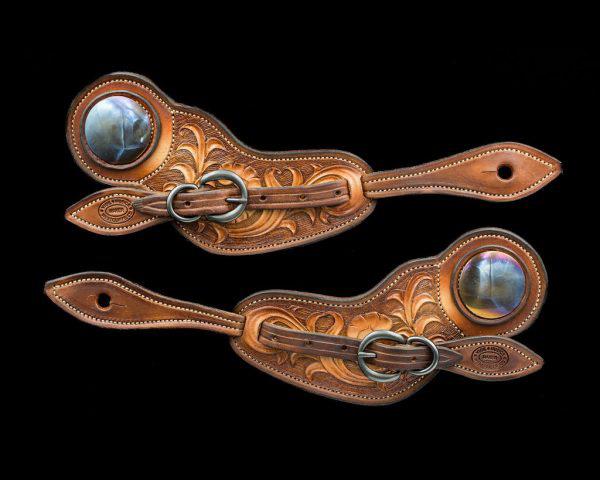
Joel Otley is a fifth-generation rancher currently residing near the Oregon/Nevada border. Joel began his braiding career while studying at Eastern Oregon University. His initial interest in braiding was to build useable tack for himself and close friends and family.
After graduating from college, he began his career cowboying for several operation throughout Oregon. He is now working toward building his own cow herd. Joel continues to braid in his spare time and continues to challenge himself to learn new techniques and patterns.
Cowboy Arts & Gear Museum 542 Commercial St. Elko, NV 89801 Museum Hours Monday, Friday, Saturday: 10am-4pm
Read about other Makers and thier entries online at cowboyartsandgearmuseum.org
toration Fund, a research initiative led by Professor Tamzen Stringham, a rangeland and riparian ecologist in the Department.
Phipps’ consulting work has spanned across the West, including in Nevada, Colorado, Arizona, Utah, California, Washington and Alaska, where he conducted biological assessments, rare plant surveys, post-fire rehabilitation and rangeland inventories, and mapping for the Bureau of Indian Affairs; and served as an expert witness for the Department of Justice on Tribal water rights.
“I’m incredibly grateful to return to the University of Nevada, Reno in this new role,” Phipps said. “It is an honor to help guide students who are passionate about land stewardship and ecological resilience. Nevada’s rangelands are both delicate and vital, and I am excited to support the communities that depend on them through research, education and collaboration.”
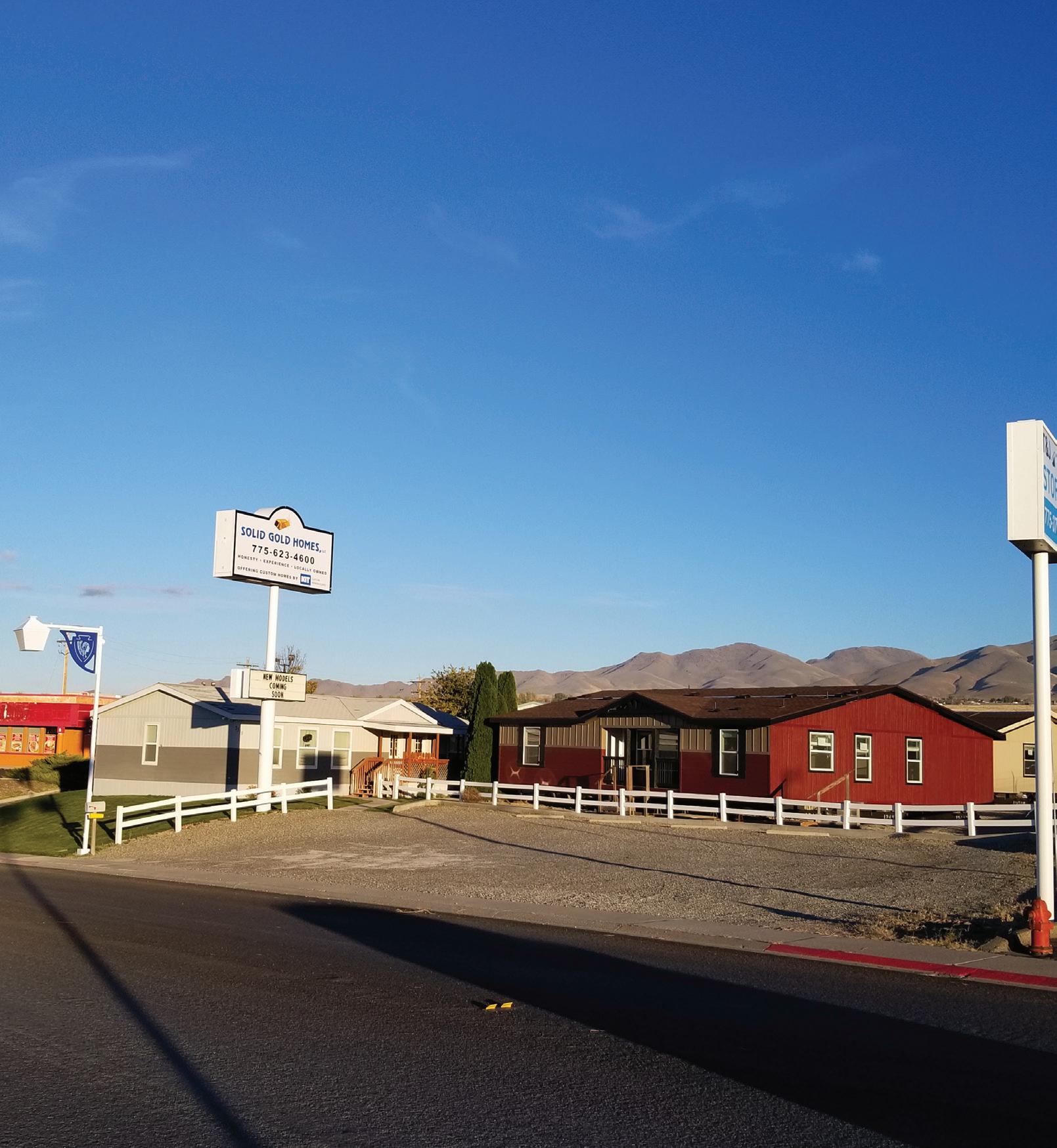
All product photos by Nicole Poyo Photography
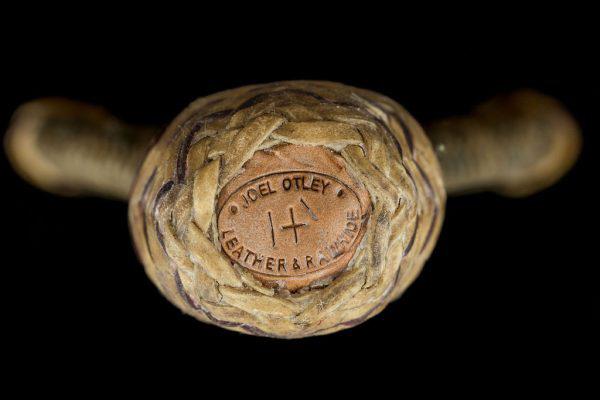




"These are two of my favorite summer recipes. Julian loved to cook, so his mom added several of his recipes to our cookbook—his peach ice cream is a hit every year! I don’t know what to say about the hot fudge, but Jo always made it for serving ice cream! There's just something about homemade fudge melting over a cold scoop that tastes like childhood. Whether you're cooling off or gathering with friends, these recipes bring smiles."
The Jackson Mountain Homemakers began in the early 1950s as a small group of women dedicated to sharing skills, recipes, and community spirit in the rural heart of Nevada. Meeting monthly in homes or community halls, they exchanged knowledge on canning, sewing, gardening, and family life. Over time, the group grew into a cornerstone of local tradition, supporting generations through education, charity work, and friendship. Their cookbooks, crafts, and events continue to reflect their enduring values. Today, the Jackson Mountain Homemakers are a nonprofit and remain a vital part of the community, honoring the past while welcoming new members and ideas for the future.
The Jackson Mountain Homemakers host an annual Basque menu fundraiser event. This event typically includes a full homemade meal with exquisit deserts, basque dancers, live auction, silent auction and raffle. The group uses funds raised to help support community members in need along with donating to other non-profits such as local PTO, youth groups, Volunteer Firemen and many others.
Follow them on Facebook for future dates!

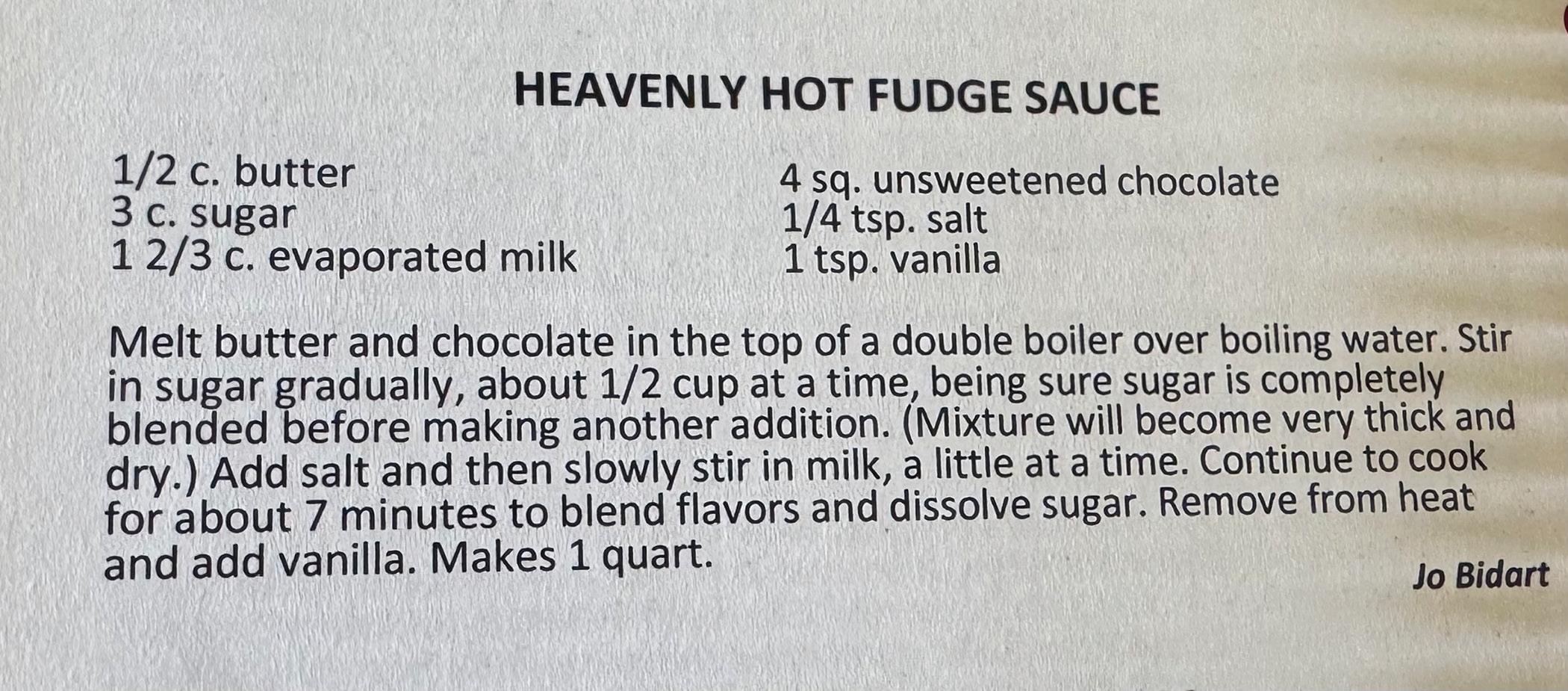

The cookbooks can be purchased through any of the homemakers, Winnemucca Essential Oils, The Winnemucca Collective, or The Spirit of Nevada Gallery. For
information Call 775-741-7907



Medusahead is a fast-spreading noxious weed across the western states. Landowners are encouraged to report it
HOW TO REPORT NEVADA’S NOXIOUS WEED EDRR SPECIES
Information about speci c EDRR (Early Detection and Rapid Response) species in Nevada can be found on the NDA’s noxious weed website. Another useful tool for identifying and reporting EDRR species is the EDDMapS phone app which can be used in the eld to review and collect information on noxious weeds
Photographs play an important role when identifying EDRR species. Photos can be submitted to Nevada’s noxious weed team at noxiousweeds@agri.nv gov or through the EDDMapS phone app or website at eddmaps org
Information to include when submitting a photograph:
Who is making the report?
Contact information is helpful if follow up is needed
What species is being reported? It is ne to guess the species if unknown
Description of the infestation: Is it a single plant or is it a dense infestation?
A minimum of one (1) photo showing the entire plant is needed for identi cation purposes. Pictures of the ower/seed head along with photos of the leaves, stem and root system are also useful
Other helpful photos may include the size of the infestation and images showing the location of the species being reported
Medusahead (Taeniatherum caput-medusae) is native to the Mediterranean region (Figure 1) Currently, three subspecies surround the Mediterranean from Spain to Morocco, and northeast into Eurasia (Frederiksen 1986; Major 1960)
Medusahead is a member of the Triticeae, a tribe of grasses which includes the important grain crops wheat (Triticum spp.), barley (Hordeum spp ), and cereal rye (Secale spp ), as well as wheatgrasses (Agropyron and Thinopyron spp ), wildryes (Elymus and Leymus spp ), and goatgrasses (Aegilops spp )
This grass tribe has its likely center of origin in the Middle East
There is evidence that some types were used for human food 23,000 years ago (Weiss et al. 2004); wheat, barley, and rye, of course, formed the basis for early agriculture and human settlement
Like many weeds from this part of the world, it is likely that medusahead accompanied agriculture from the earliest days
Medusahead spikes have been found in 9,000-year old storage jars from the Neolithic town of Çatalhöyük, in central Turkey, alongside jars of primitive cultivars of wheat and barley (Fairbairn et al. 2007; Helbæk 1964). Helbæk commented, “What the ancient people wanted them for is impossible to guess ”

Introduction to North America
Medusahead was rst recorded in the United States near Roseburg, Oregon, in 1887 (Howell 1903) Herbarium records indicate that the plant spread concentrically — north into Washington, south into California, and east into the Great Basin, Idaho, and other western states — but most rapidly in the direction of California (Major et al. 1960).
Recent genetic analysis suggests that at least seven distinct genotypes of medusahead have been introduced over a timespan from 1887 to as recently as 1988, and that the plant has more genetic diversity here than previously thought (Novak and Sforza 2008) It is not known how medusahead was introduced to the United States
It has been suggested that medusahead arrived as a contaminant in cereal grain seed, while others (George 1992; Hilken and Miller 1980) suggest it may have arrived clinging to the fur of imported livestock. Because medusahead seeds are smaller than most cereal grains, and because this plant goes to seed later than most domesticated cereals, the fur hypothesis seems most likely
In addition, during its subsequent spread from the point of introduction, medusahead has been strongly associated with areas of livestock
production. For example, in the 1960s isolated populations were found in the eastern Sierra Nevada in areas used to corral sheep (Young 1992)
SPREAD AND DISTRIBUTION
Once introduced to the western US, medusahead spread rapidly in low-elevation annual grasslands, oak woodlands, and chaparral communities (Young 1992) These west coast communities have a Mediterranean-type climate comparable to medusahead’s native region: hot and dry in summer, and cool and moist from late fall through spring Mediterranean winter annuals such as medusahead generally germinate in fall and ower and set seed in spring Medusahead invaded the intermountain region, east of the Sierra and Cascade ranges, at a much slower rate. It was rst reported in this region at Verdi, Nevada, in the early 1960s (Young 1992) Medusahead is somewhat moisture-limited in the Great Basin and appears to favor clay soils (Dahl and Tisdale 1975) Where established, however, it has the potential to outcompete downy brome (Bromus tectorum, also called cheatgrass) (Hironaka 1994).
It continues to expand its range by about 12% per year and recently was estimated to infest over 2 4
African rue (Peganum harmala)
austriaca)
Austrian peaweed (Sphaerophysa salsula)
Barbed goatgrass (Aegilops triuncialis)
ciliare)
Camelthorn (Alhagi pseudalhagi)
Common crupina (Crupina vulgaris)
Curly-leaf pondweed (Potamogton crispus)
Desert knapweed (Volutaria
Dyer’s woad (Isatis tinctoria)
Eurasian water-milfoil (Myriophyllum spicatum)
Flowering rush (Butomus umbellatus)
Giant salvinia (Salvinia molesta)
Green fountain grass (Pennisetum setaceum)
Houndstongue (Cynoglossum
Hydrilla (Hydrilla verticillata)
Iberian starthistle (Centaurea iberica)
Jointed goatgrass (Aegilops cylindrical)
Klamath weed (Hypericum peerforatum)
Malta starthistle (Centaurea melitensis)
Mediterranean sage (Salvia aethiopis)
Medusahead (Taeniatherum caput-medusae)
Purple loosestrife (Lythrum salicaria)
Purple starthistle (Centaurea calcitrapa)
Rush skeletonweed (Chondrilla juncea)
million acres (950,000 ha) in the 17 western states (Rice 2005). In California, medusahead now occupies more than a million acres of annual dominated grassland, oak woodland, and chaparral communities (Duncan et al. 2004)
It is found almost statewide, except for the high Sierra and the southern deserts (Jepson eFlora 2014). In Idaho and Oregon, rangeland infested with medusahead approximately doubled in the last 40 years of the 20th century (Davies and Johnson 2008)
This weed is now found in almost every Oregon county, in most of western and southern Idaho, eastern Washington, and northern Nevada. It occurs in patches in Utah and Arizona and has recently been reported in the eyebrow of Montana Medusahead is a state-listed noxious weed in California, Colorado, Nevada, Oregon, and Utah
MECHANISMS OF SPREAD
Hooks, barbs, and awns are common adaptations in seeds transported by animals (Shmida and Ellner 1983; Sorensen 1986). Medusahead seeds are small, with long awns barbed with silica scales. These seeds are well suited for attaching to animal fur, clothing, vehicles, and machinery
It is thought that medium-range
Squarrose knapweed (Centaurea virgata)
Sulfur cinquefoil (Potentilla recta)
Syrian bean caper (Zygophyllum fabago)
Ventenata (Ventenata dubia)
Yellow starthistle (Centaurea solstitialis)
vulgaris)
dispersal of medusahead is primarily by travel in coats of livestock . The seeds do not appear to be stashed by rodents (Longland 1994) or used by birds (Goebel and Berry 1976)
Long-range dispersal for example, the introduction of medusahead to North America, or movement from lowland pastures to the intermountain region is probably always abetted by human activity
Dissemination might occur by seeds attaching to clothing or vehicles or to livestock being trucked to seasonal grazing sites. In a survey of medusahead distribution in southeastern Oregon, Davies et al (2013) found that infestations were concentrated along travel routes Go to bit.ly/2UOqdI8 to read more on the management of medusahead in the “Medusahead Management Guide for the Western States ”
By Kori Dover, RD
As more people look for variety and meaning in their meals, global flavors are gaining traction, not just for taste, but for the way traditional dishes can bring together balance, culture, and everyday ingredients. Meals like this Picadillo-Style Beef Stir-Fry show how global inspiration can help us build dishes that deliver key nutrients like iron, zinc, and B vitamins, all while adding bold flavor and variety to the plate. Pairing lean beef with produce and pantry staples is a simple way to create meals that can support energy, fullness, and overall well-being.


Ingredients:
•1 pound beef Top Sirloin Steak Boneless, cut 1 inch thick
•1-1/2 teaspoons ground cumin
•1 teaspoon dried oregano
•1 tablespoon olive oil, divided
•1 large all-purpose potato, peeled, cut into 1/2-inch chunks
•1 medium onion, thinly sliced
•1 medium green bell pepper, thinly sliced
•1 can (15 ounces) tomato sauce Nourishing Meals with Global Roots
•1/2 cup raisins
Serving Suggestions:
•Warmed flour tortillas or hot cooked rice, toasted sliced almonds, chopped fresh cilantro, sour cream (optional)
Cooking:
1.Cut beef Top Sirloin Steak Boneless lengthwise in half, then crosswise into 1/8 to 1/4-inch thick strips. Combine beef strips, cumin and oregano in medium bowl; toss to coat.
2.Heat 1 teaspoon oil in large nonstick skillet over medium-high heat until hot. Add 1/2 of beef; stir-fry 1 to 3 minutes or until outside surface of beef is no longer pink (For food safety, the USDA recommends an internal cooking temperature of 145F for medium rare steaks, as measured by a meat thermometer). Remove from skillet. Repeat with remaining beef and additional 1 teaspoon oil. Season with salt, as desired; keep warm.
3.Heat remaining 1 teaspoon oil in same skillet over medium heat until hot. Add potato, onion and pepper. Cook and stir 5 minutes. Add tomato sauce and raisins; bring to a boil. Reduce heat; cover and simmer 15 to 18 minutes or until potato is tender; stirring occasionally. Add beef; cook until heated through, about 1 to 2 minutes. Season with salt, as desired.
4.Serve beef mixture in tortillas or over hot cooked rice topped with almonds, cilantro and sour cream, as desired.
Recipe from BeefItsWhatsForDinner.com, funded by the Beef Checkoff.
Per NRS Chapters 575, 561 and 567 the Nevada Department of Agriculture (NDA) has authority and is required to collect certain taxes on livestock. These taxes include: 1) Livestock Inspection Tax, which helps support the brand inspection program, livestock and horse theft investigations and animal health issues; 2) Wool Growers Predatory Animal and Rodent Control Tax which helps support the predatory animal damage control program; and 3) Sheep Inspection Tax which supports sheep disease control and other activities related to Nevada’s sheep industry.

Go to: https://nv.certifyag.com/ headtax/
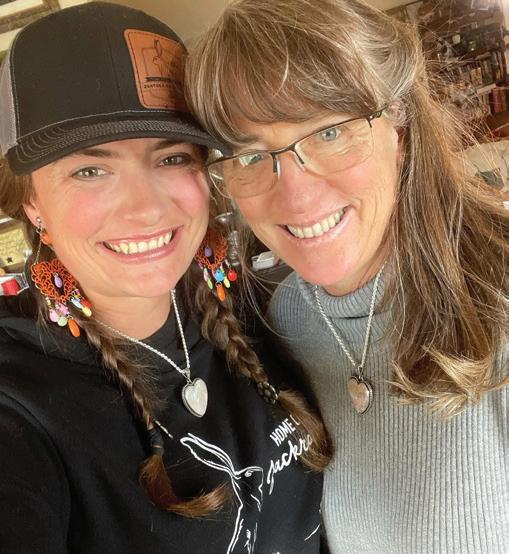
“She's an old butter crock with a chip in the side,
She's a picture in a frame of a cowboy and his bride,
Administered by NDA, this program was put in place by livestock owners during the 1961 Nevada Legislature for the protection of their livestock and is funded by inspection fees and assessments. To keep the fees as low as possible, each livestock owner must declare and pay their annual fees.
If total head tax is more than $0 and less than $10, NRS Chapters 575.185 and 562.170 require a $10 minimum payment, unless you only raise sheep. In that case your minimum payment is $5.
Per Nevada Revised Statute (NRS) Chapter 575.130, all Nevada Livestock Assessments must be paid within 30 days of notification to avoid a $5 late fee assessment, deactivation of brand(s) and denial of future brand inspections.
To retrieve your account, log in using your Assessment Number (LA#) and Pass Code (received in your assessment letter) below. Please DO NOT CREATE A NEW ACCOUNT EACH YEAR.
Update your contact information if necessary.
Select year from drop down box to apply payment to current or delinquent year. Complete your livestock inventory.
Pay online with a credit card or e-check.
If you have questions, please call the Elko office at 775-753-1360.
She's a pair of gentle hands holding fevered heads,
She's the same five stories, each night before bed,
She's a white four door pickup with 300 thousand miles,
She's a box of undeveloped film rolls, 300 thousand smiles,
She's sewing in the front seat as Daddy drives to a rodeo,
She' teaching us to enjoy, sunshine, rain, and snow,
She's one little girl and two little boys that she calls her "Huckleberries",
She's teacher, cook, chauffeur, and reigning champion of Yahzee,
She's little goat kids, and bottle calves, and loud 80's music,
She's sleeping in, kitchen
dancin', and See's Dark Chocolate,
She's driving to 4-H and T-Ball, gymnastics, wrestling, and rodeo,
She's "Footloose" and "Tombstone", "Top-Gun" and "A League of Their Own",
She's baseball and buckaroos, big ranches and small towns,
She's faster than the speed limit and All American proud,
She's antique crystal dishes, and the newest music player,
She's fireplaces, fuzzy blankets, praise, and prayer,
She's a work ethic that doesn't quit and a house full of laughter,
She's wife and mom to cowboys, and a grateful cowboy daughter.
In loving memory of Sherri "Momma" Johnson.
Poem by Randi Johnson 2024 The Cowboys Daughter.

The Nevada Department of Agriculture (NDA) announced the retirement of State Entomologist Jeff Knight, effective July 4, 2025, following an extraordinary 40-year career dedicated to safeguarding Nevada's agricultural and natural ecosystems.
“Insects have fascinated me since I was a kid, so this career has truly fulfilled a dream,” said Knight. “This career has taken me to remote areas of Nevada to study and discover insects I may not have gotten to see otherwise. The last 40 years have been rewarding, but it’s not the end. If you see a guy pulled over on the side of a dirt road with a bug net, it may very well be me.”
Knight's lifelong passion for entomology began in childhood, fostered through his involvement in 4-H programs. He earned a Bachelor of Science in Pest Management from the University of Nevada, Reno, and furthered his expertise with a Master of Science in Entomology from Utah State University. He began his tenure with the NDA as an entomology seasonal in 1976.
In 1993, Knight was promoted to State Entomologist, a role in which he became a tireless advocate for environmental stewardship and a pivotal figure in protecting Nevada’s agricultural interests. His extensive work included safeguarding the state's economy and food security from invasive species and agricultural pests. He played a crucial role in the development and curation of the State of Nevada Entomology Collection, cataloging new species discovered within the state and significantly
expanding formal state records for various species. Jeff Knight’s contributions extended to identifying countless samples from the public and the agriculture community, offering invaluable insights and management recommendations that have bolstered the state’s sustainable practices and protected its valuable ecosystems.
"Jeff has been a truly invaluable member of the NDA for four decades," said NDA Director J.J. Goicoechea. "His dedication to protecting Nevada's agriculture and educating the public on sustainable practices is unparalleled. We thank him for the immense amount of work he has dedicated to Nevada over the last 40 years. No one knows more about the pests, people and politics of Nevada than Jeff.”
"Jeff has been a vital member of the NDA team,” said Meghan Brown, Administrator for the Division of Plant Health and Compliance. "His depth of knowledge and unwavering commitment to the state have shaped countless initiatives and inspired everyone around him. He will be deeply missed, but his legacy will continue to guide our efforts for years to come."
“Working alongside Jeff has been an absolute privilege,” added Ray Saliga, Deputy Administrator of the NDA Division of Plant Health and Compliance. “We wish him the best in his well-deserved retirement.”
The NDA extends its deepest gratitude to Jeff Knight for his exceptional service and profound impact on the
An entomologist is a scientist who studies insects. They focus on all aspects of insect life, including the oles insects play in ecosystems. Their impact on agriculture, human health, and the environment.




CALIFORNIA REPRESENTATIVES
Jake Parnell 916-662-1298
George Gookin 209-482-1648
Rex Whittle 209-996-6994
Mark Fischer 209-768-6522
Kris Gudel 916-208-7258
Steve Bianchi 707-484-3903
Jason Dailey 916-439-7761
NEVADA REPRESENTATIVES
Tod Radelfinger 775-901-3332
Bowdy Griffin 530-906-5713
Brett Friend 510-685-4870
WEDNESDAY WEEKLY SCHEDULE
Butcher Cows ................................... 8:30 a.m.
Cow-Calf Pairs/Bred Cows ..... 11:30 a.m.
Feeder Cattle ........................................ 12 p.m.
AUCTION MARKET
12495 E. STOCKTON BLVD., GALT, CA
CLM SPECIAL FEEDER SALES
August 13
September 10 & 24
October 15 & 29
November 12 & 26
December 3 & 17
SATURDAY, AUGUST 9, 10 A.M.
– EARLY CONSIGNMENTS –
40 BRED HEIFERS FROM RENZ RANCHES Foothill- and Anaplas-Raised, Bred to Calving-Ease Donati Ranch and Thomas Angus Bulls, Due to Calve 9/1
120 COWS FROM RAFTER 7 LIVESTOCK Running on the Dry, Bred to EZ Angus Bulls, Due to Calve 8/15
65 YOUNG, FOOTHILL-RUN COWS FROM MATT FISCHER – Bred to Angus Bulls
40 BLACK, 3- & 4-YEAR-OLD COWS FROM RYAN MORGAN
15 FANCY, BRED HEIFERS FROM JACKSON RANCHERIA
35 BRED HEIFERS FROM MARTIN LIVESTOCK

Office........................................... 209-745-1515
Fax ............................................... 209-745-1582
Website/Market Report ... www.clmgalt.com Web Broadcast ...... www.lmaauctions.com

CALL NOW TO CONSIGN TO THIS WESTERN VIDEO MARKET SALE: September 16 – Haythorn Ranch, Ogallala, NE CONSIGNMENT DEADLINE: AUGUST 28





